Project Management Cycle Plan for Construction Project
VerifiedAdded on 2024/04/25
|32
|7156
|85
AI Summary
This detailed report covers the project management cycle plan for a construction project assigned by the London School of Science and Technology. It includes aspects like resource management, project leadership, and performance evaluation techniques.
Contribute Materials
Your contribution can guide someone’s learning journey. Share your
documents today.
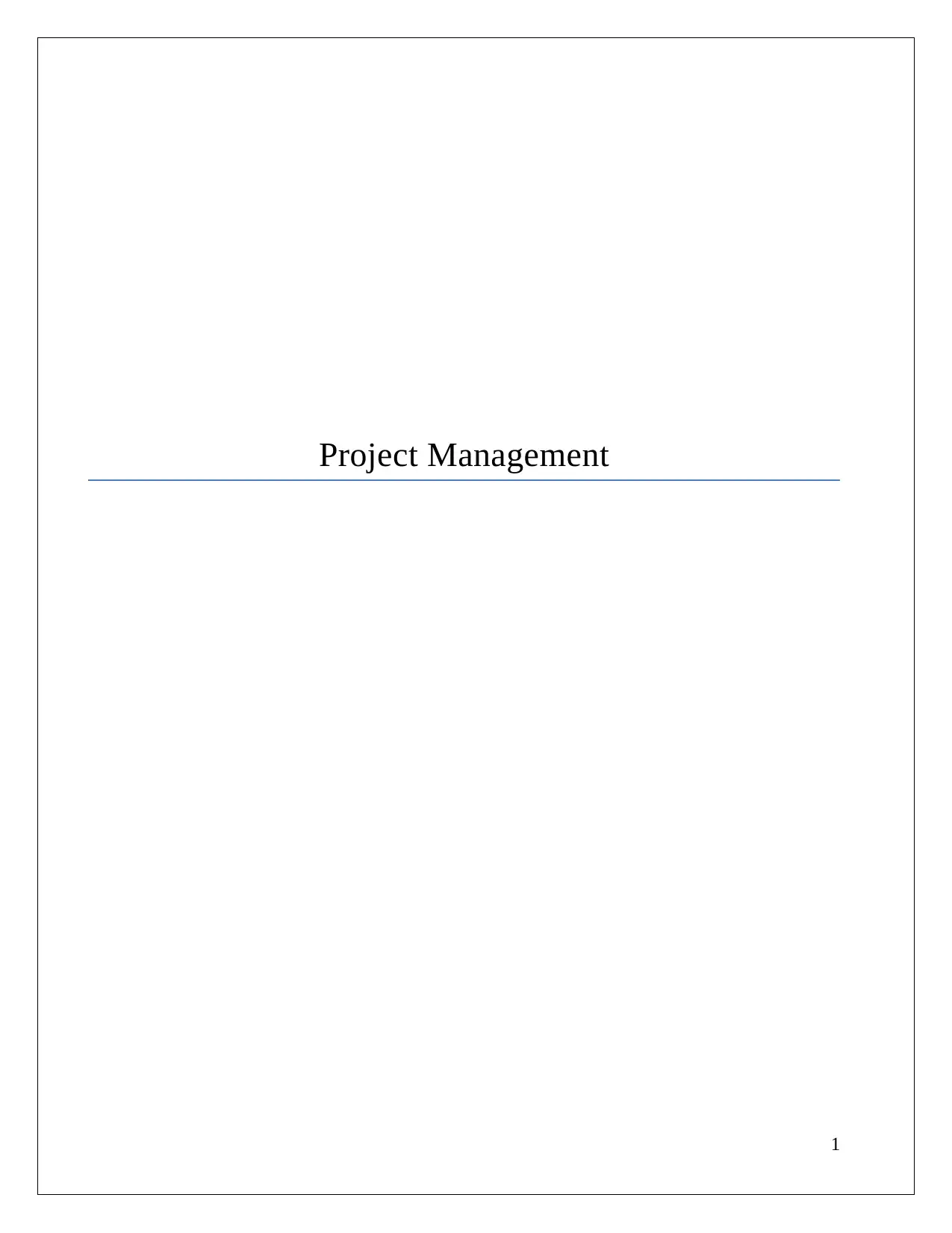
Project Management
1
1
Secure Best Marks with AI Grader
Need help grading? Try our AI Grader for instant feedback on your assignments.
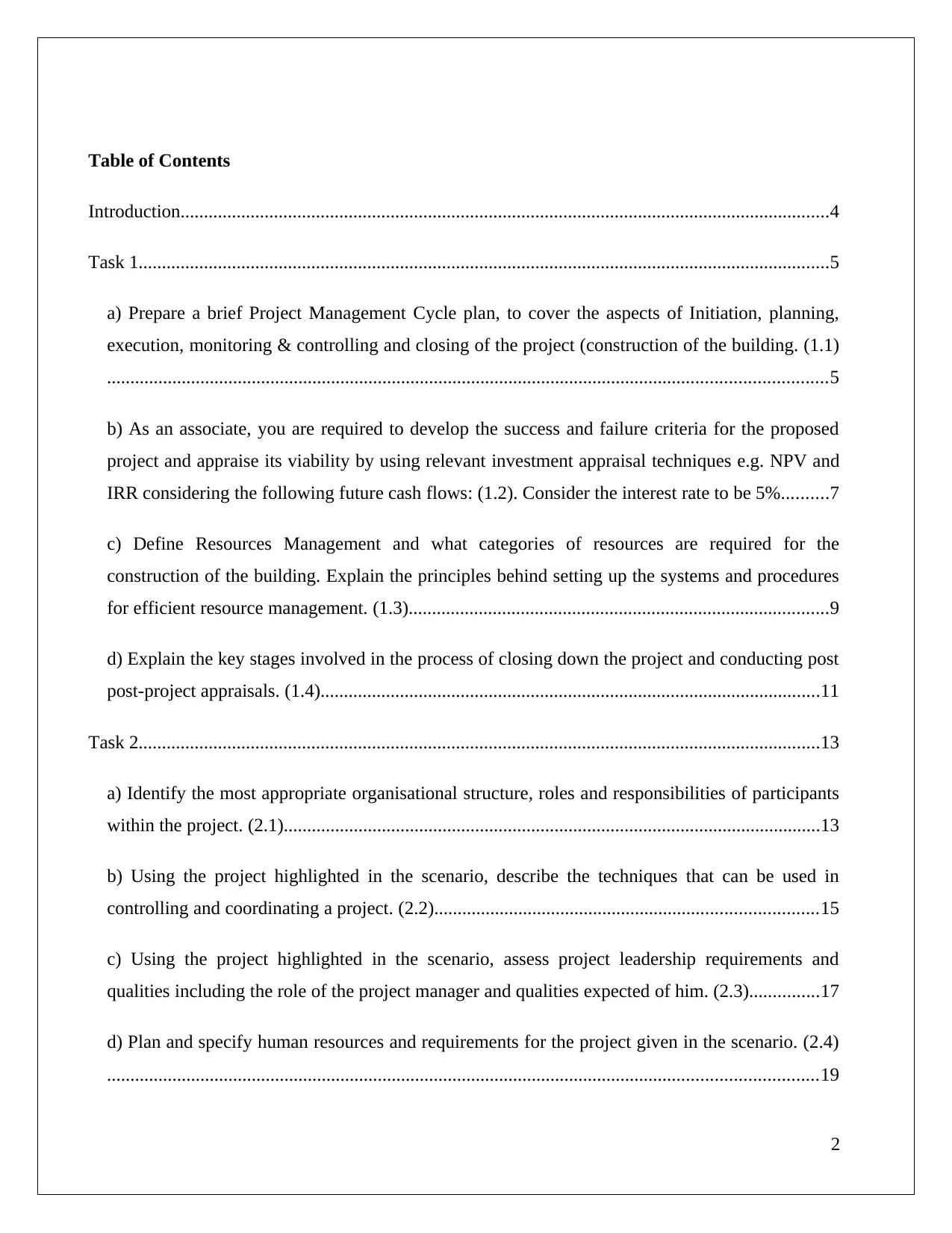
Table of Contents
Introduction...........................................................................................................................................4
Task 1....................................................................................................................................................5
a) Prepare a brief Project Management Cycle plan, to cover the aspects of Initiation, planning,
execution, monitoring & controlling and closing of the project (construction of the building. (1.1)
..........................................................................................................................................................5
b) As an associate, you are required to develop the success and failure criteria for the proposed
project and appraise its viability by using relevant investment appraisal techniques e.g. NPV and
IRR considering the following future cash flows: (1.2). Consider the interest rate to be 5%..........7
c) Define Resources Management and what categories of resources are required for the
construction of the building. Explain the principles behind setting up the systems and procedures
for efficient resource management. (1.3)..........................................................................................9
d) Explain the key stages involved in the process of closing down the project and conducting post
post-project appraisals. (1.4)...........................................................................................................11
Task 2..................................................................................................................................................13
a) Identify the most appropriate organisational structure, roles and responsibilities of participants
within the project. (2.1)...................................................................................................................13
b) Using the project highlighted in the scenario, describe the techniques that can be used in
controlling and coordinating a project. (2.2)..................................................................................15
c) Using the project highlighted in the scenario, assess project leadership requirements and
qualities including the role of the project manager and qualities expected of him. (2.3)...............17
d) Plan and specify human resources and requirements for the project given in the scenario. (2.4)
........................................................................................................................................................19
2
Introduction...........................................................................................................................................4
Task 1....................................................................................................................................................5
a) Prepare a brief Project Management Cycle plan, to cover the aspects of Initiation, planning,
execution, monitoring & controlling and closing of the project (construction of the building. (1.1)
..........................................................................................................................................................5
b) As an associate, you are required to develop the success and failure criteria for the proposed
project and appraise its viability by using relevant investment appraisal techniques e.g. NPV and
IRR considering the following future cash flows: (1.2). Consider the interest rate to be 5%..........7
c) Define Resources Management and what categories of resources are required for the
construction of the building. Explain the principles behind setting up the systems and procedures
for efficient resource management. (1.3)..........................................................................................9
d) Explain the key stages involved in the process of closing down the project and conducting post
post-project appraisals. (1.4)...........................................................................................................11
Task 2..................................................................................................................................................13
a) Identify the most appropriate organisational structure, roles and responsibilities of participants
within the project. (2.1)...................................................................................................................13
b) Using the project highlighted in the scenario, describe the techniques that can be used in
controlling and coordinating a project. (2.2)..................................................................................15
c) Using the project highlighted in the scenario, assess project leadership requirements and
qualities including the role of the project manager and qualities expected of him. (2.3)...............17
d) Plan and specify human resources and requirements for the project given in the scenario. (2.4)
........................................................................................................................................................19
2
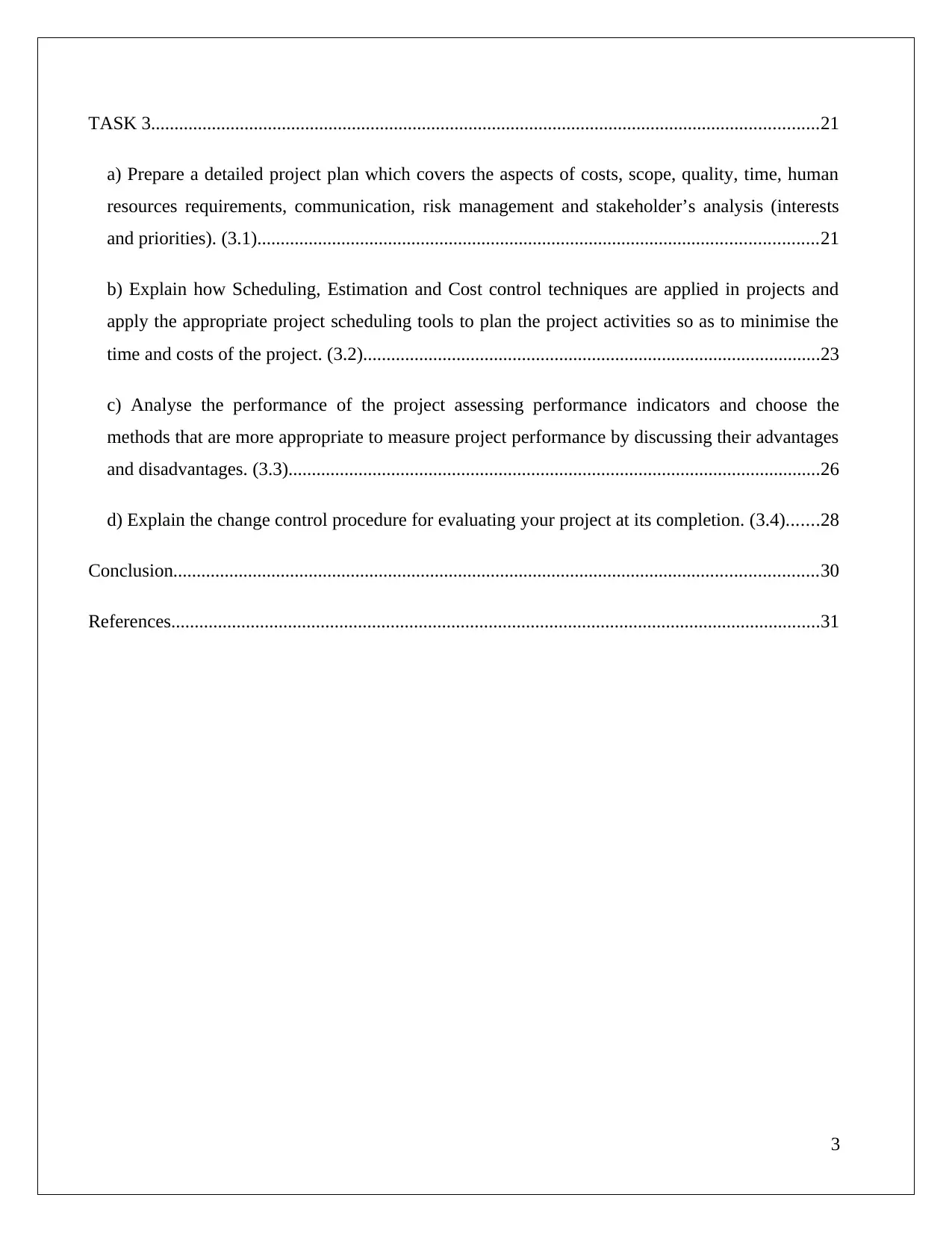
TASK 3...............................................................................................................................................21
a) Prepare a detailed project plan which covers the aspects of costs, scope, quality, time, human
resources requirements, communication, risk management and stakeholder’s analysis (interests
and priorities). (3.1)........................................................................................................................21
b) Explain how Scheduling, Estimation and Cost control techniques are applied in projects and
apply the appropriate project scheduling tools to plan the project activities so as to minimise the
time and costs of the project. (3.2)..................................................................................................23
c) Analyse the performance of the project assessing performance indicators and choose the
methods that are more appropriate to measure project performance by discussing their advantages
and disadvantages. (3.3)..................................................................................................................26
d) Explain the change control procedure for evaluating your project at its completion. (3.4).......28
Conclusion..........................................................................................................................................30
References...........................................................................................................................................31
3
a) Prepare a detailed project plan which covers the aspects of costs, scope, quality, time, human
resources requirements, communication, risk management and stakeholder’s analysis (interests
and priorities). (3.1)........................................................................................................................21
b) Explain how Scheduling, Estimation and Cost control techniques are applied in projects and
apply the appropriate project scheduling tools to plan the project activities so as to minimise the
time and costs of the project. (3.2)..................................................................................................23
c) Analyse the performance of the project assessing performance indicators and choose the
methods that are more appropriate to measure project performance by discussing their advantages
and disadvantages. (3.3)..................................................................................................................26
d) Explain the change control procedure for evaluating your project at its completion. (3.4).......28
Conclusion..........................................................................................................................................30
References...........................................................................................................................................31
3
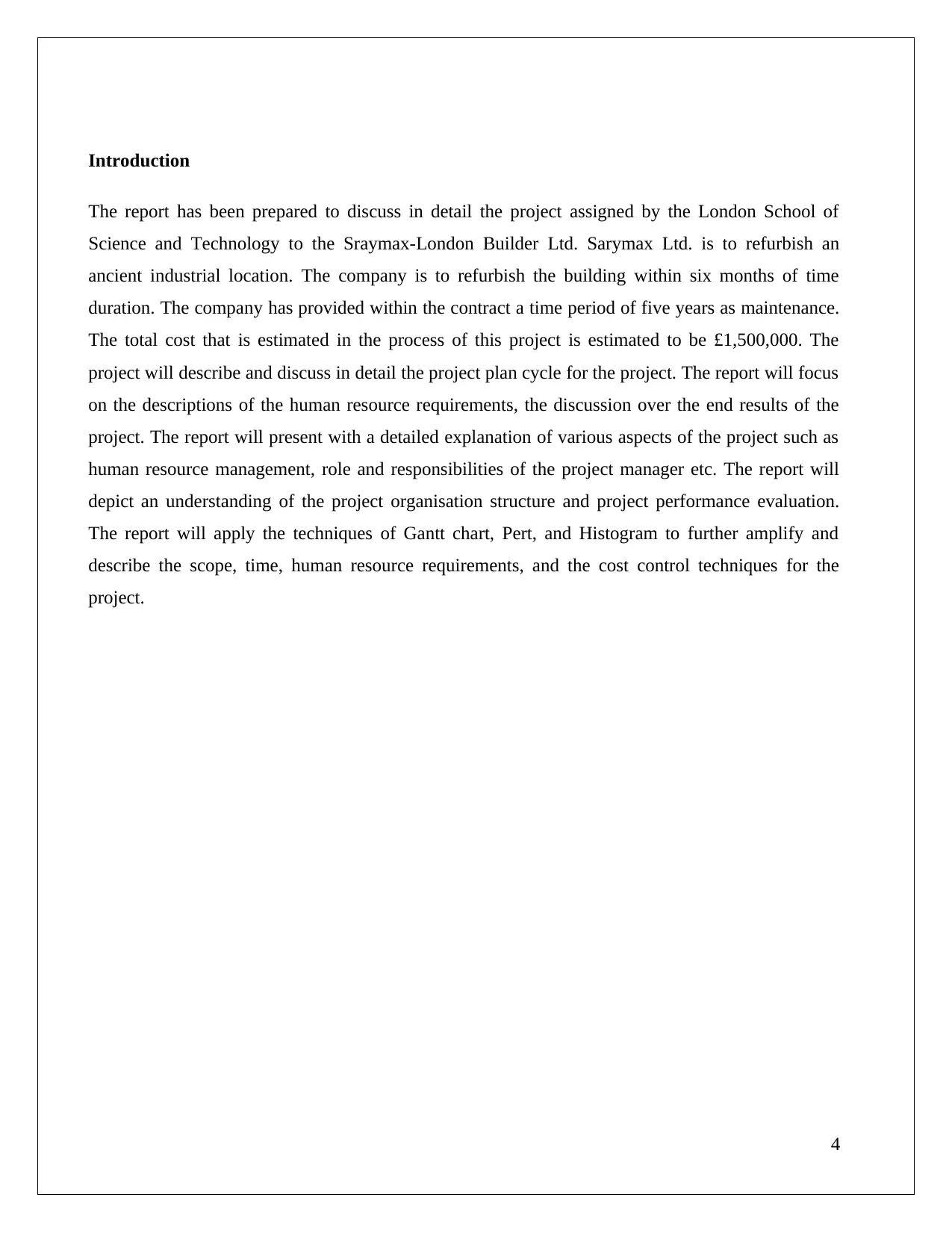
Introduction
The report has been prepared to discuss in detail the project assigned by the London School of
Science and Technology to the Sraymax-London Builder Ltd. Sarymax Ltd. is to refurbish an
ancient industrial location. The company is to refurbish the building within six months of time
duration. The company has provided within the contract a time period of five years as maintenance.
The total cost that is estimated in the process of this project is estimated to be £1,500,000. The
project will describe and discuss in detail the project plan cycle for the project. The report will focus
on the descriptions of the human resource requirements, the discussion over the end results of the
project. The report will present with a detailed explanation of various aspects of the project such as
human resource management, role and responsibilities of the project manager etc. The report will
depict an understanding of the project organisation structure and project performance evaluation.
The report will apply the techniques of Gantt chart, Pert, and Histogram to further amplify and
describe the scope, time, human resource requirements, and the cost control techniques for the
project.
4
The report has been prepared to discuss in detail the project assigned by the London School of
Science and Technology to the Sraymax-London Builder Ltd. Sarymax Ltd. is to refurbish an
ancient industrial location. The company is to refurbish the building within six months of time
duration. The company has provided within the contract a time period of five years as maintenance.
The total cost that is estimated in the process of this project is estimated to be £1,500,000. The
project will describe and discuss in detail the project plan cycle for the project. The report will focus
on the descriptions of the human resource requirements, the discussion over the end results of the
project. The report will present with a detailed explanation of various aspects of the project such as
human resource management, role and responsibilities of the project manager etc. The report will
depict an understanding of the project organisation structure and project performance evaluation.
The report will apply the techniques of Gantt chart, Pert, and Histogram to further amplify and
describe the scope, time, human resource requirements, and the cost control techniques for the
project.
4
Paraphrase This Document
Need a fresh take? Get an instant paraphrase of this document with our AI Paraphraser

Task 1
a) Prepare a brief Project Management Cycle plan, to cover the aspects of Initiation, planning,
execution, monitoring & controlling and closing of the project (construction of the building.
(1.1)
Project Management Cycle Plan is comprehended and data-based plan which is adopted by the
organisation to execute the construction of the new building. The cycle consists of various stages
such as initiation, planning, execution, monitoring, controlling and closing of the project. All these
stages occur in the process of a project. For Sraymax to construct the new building the following
project management cycle plan has been adopted.
(Figure 1: Project Management Cycle Plan)
(Source: Kerzner and Saladis, 2017).
5
a) Prepare a brief Project Management Cycle plan, to cover the aspects of Initiation, planning,
execution, monitoring & controlling and closing of the project (construction of the building.
(1.1)
Project Management Cycle Plan is comprehended and data-based plan which is adopted by the
organisation to execute the construction of the new building. The cycle consists of various stages
such as initiation, planning, execution, monitoring, controlling and closing of the project. All these
stages occur in the process of a project. For Sraymax to construct the new building the following
project management cycle plan has been adopted.
(Figure 1: Project Management Cycle Plan)
(Source: Kerzner and Saladis, 2017).
5
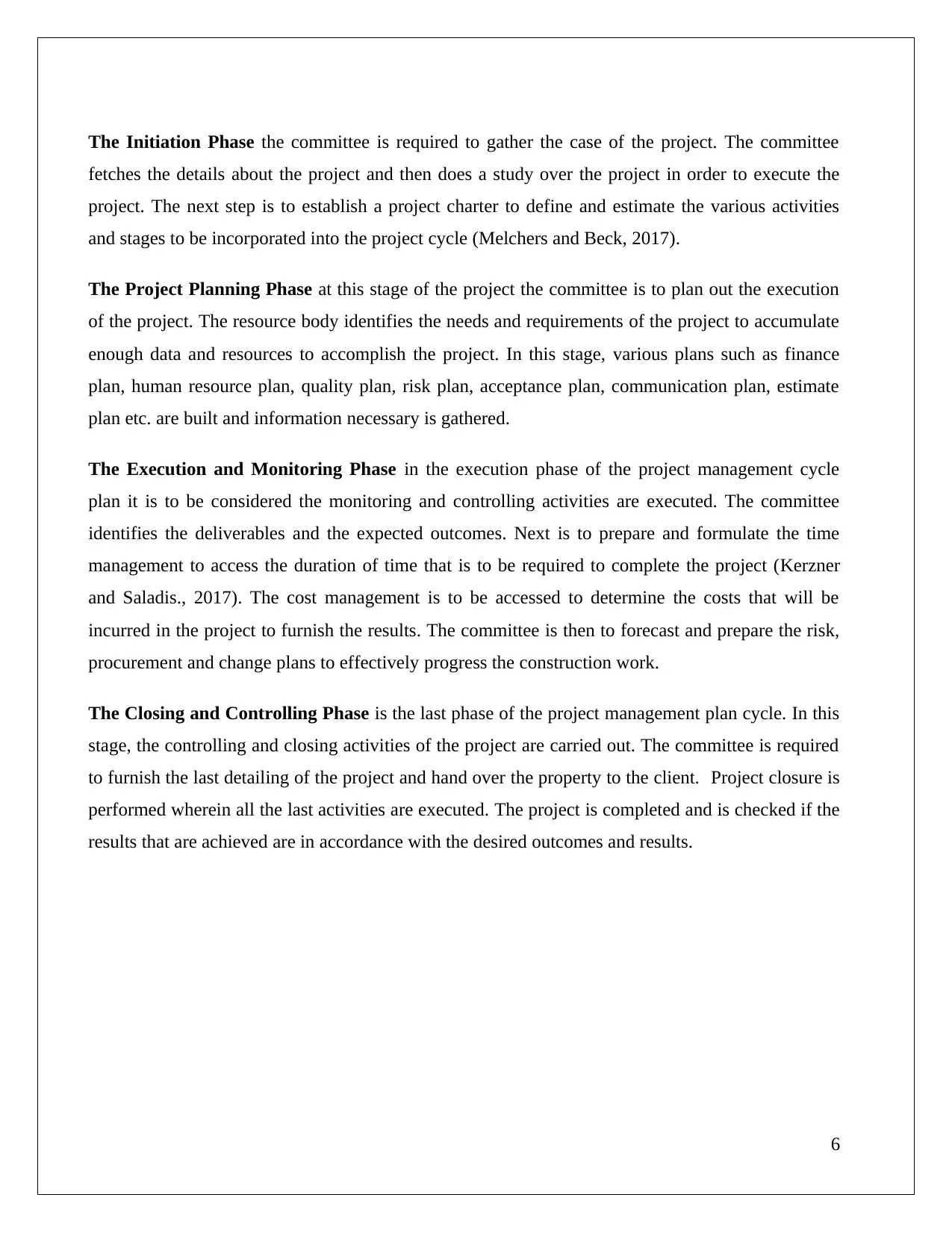
The Initiation Phase the committee is required to gather the case of the project. The committee
fetches the details about the project and then does a study over the project in order to execute the
project. The next step is to establish a project charter to define and estimate the various activities
and stages to be incorporated into the project cycle (Melchers and Beck, 2017).
The Project Planning Phase at this stage of the project the committee is to plan out the execution
of the project. The resource body identifies the needs and requirements of the project to accumulate
enough data and resources to accomplish the project. In this stage, various plans such as finance
plan, human resource plan, quality plan, risk plan, acceptance plan, communication plan, estimate
plan etc. are built and information necessary is gathered.
The Execution and Monitoring Phase in the execution phase of the project management cycle
plan it is to be considered the monitoring and controlling activities are executed. The committee
identifies the deliverables and the expected outcomes. Next is to prepare and formulate the time
management to access the duration of time that is to be required to complete the project (Kerzner
and Saladis., 2017). The cost management is to be accessed to determine the costs that will be
incurred in the project to furnish the results. The committee is then to forecast and prepare the risk,
procurement and change plans to effectively progress the construction work.
The Closing and Controlling Phase is the last phase of the project management plan cycle. In this
stage, the controlling and closing activities of the project are carried out. The committee is required
to furnish the last detailing of the project and hand over the property to the client. Project closure is
performed wherein all the last activities are executed. The project is completed and is checked if the
results that are achieved are in accordance with the desired outcomes and results.
6
fetches the details about the project and then does a study over the project in order to execute the
project. The next step is to establish a project charter to define and estimate the various activities
and stages to be incorporated into the project cycle (Melchers and Beck, 2017).
The Project Planning Phase at this stage of the project the committee is to plan out the execution
of the project. The resource body identifies the needs and requirements of the project to accumulate
enough data and resources to accomplish the project. In this stage, various plans such as finance
plan, human resource plan, quality plan, risk plan, acceptance plan, communication plan, estimate
plan etc. are built and information necessary is gathered.
The Execution and Monitoring Phase in the execution phase of the project management cycle
plan it is to be considered the monitoring and controlling activities are executed. The committee
identifies the deliverables and the expected outcomes. Next is to prepare and formulate the time
management to access the duration of time that is to be required to complete the project (Kerzner
and Saladis., 2017). The cost management is to be accessed to determine the costs that will be
incurred in the project to furnish the results. The committee is then to forecast and prepare the risk,
procurement and change plans to effectively progress the construction work.
The Closing and Controlling Phase is the last phase of the project management plan cycle. In this
stage, the controlling and closing activities of the project are carried out. The committee is required
to furnish the last detailing of the project and hand over the property to the client. Project closure is
performed wherein all the last activities are executed. The project is completed and is checked if the
results that are achieved are in accordance with the desired outcomes and results.
6

b) As an associate, you are required to develop the success and failure criteria for the
proposed project and appraise its viability by using relevant investment appraisal techniques
e.g. NPV and IRR considering the following future cash flows: (1.2). Consider the interest rate
to be 5%
It can be stated that if the Total of PV of cash flow is less than the initial outlay then the project is
not viable. It can also be said that proposed project is not appropriate and profitable for the company
if the PV of cash flow is less than an expenditure made.
Since the PV of Cash flow (£1993.63) is greater than Initial outlay (£1500) the project is viable and
profitable for the company.
IRR is also useful for the determination of the viability of the project.
It can be stated that @ 19.86 the PV of the cash flow will be equal to the initial outlay.
7
proposed project and appraise its viability by using relevant investment appraisal techniques
e.g. NPV and IRR considering the following future cash flows: (1.2). Consider the interest rate
to be 5%
It can be stated that if the Total of PV of cash flow is less than the initial outlay then the project is
not viable. It can also be said that proposed project is not appropriate and profitable for the company
if the PV of cash flow is less than an expenditure made.
Since the PV of Cash flow (£1993.63) is greater than Initial outlay (£1500) the project is viable and
profitable for the company.
IRR is also useful for the determination of the viability of the project.
It can be stated that @ 19.86 the PV of the cash flow will be equal to the initial outlay.
7
Secure Best Marks with AI Grader
Need help grading? Try our AI Grader for instant feedback on your assignments.
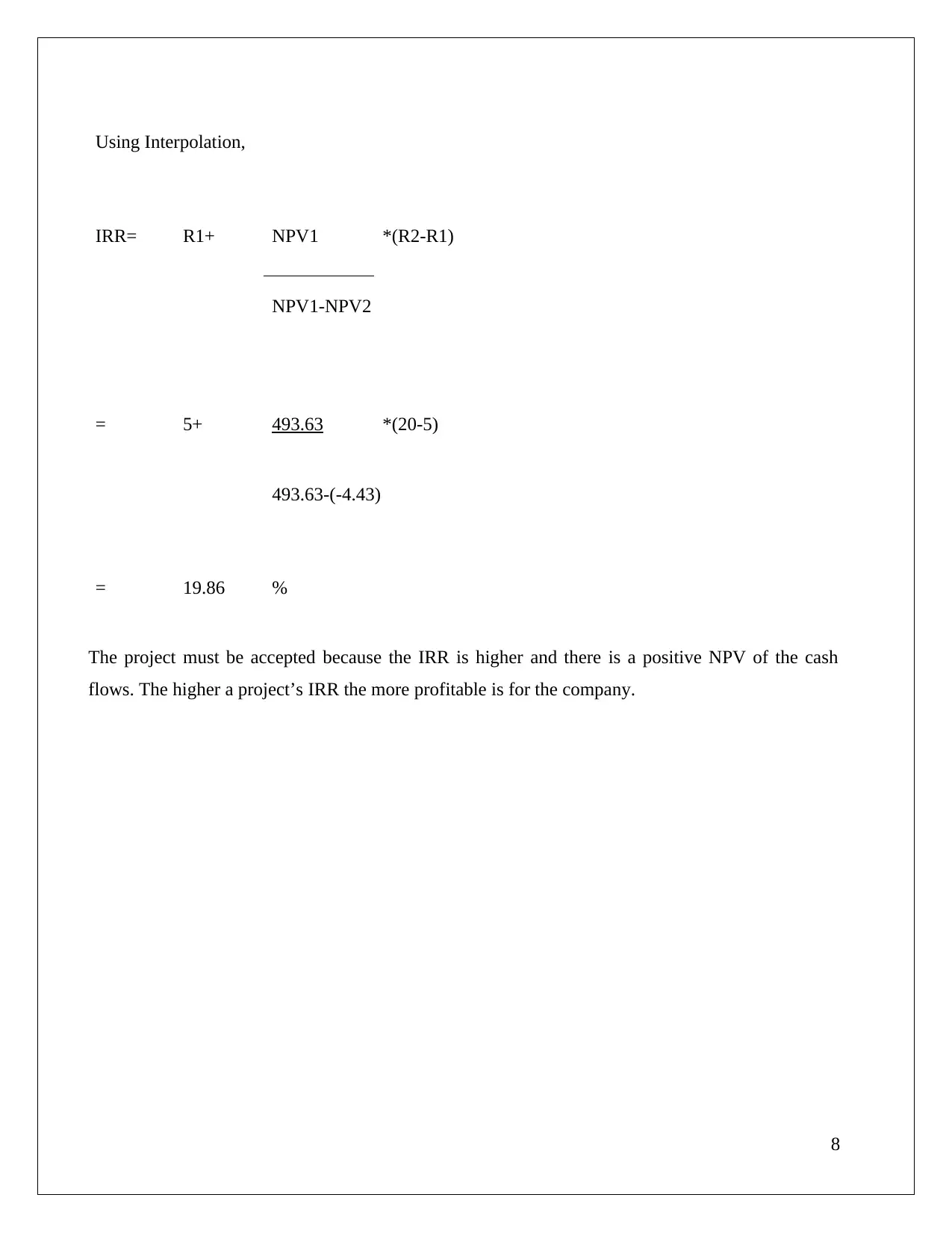
Using Interpolation,
IRR= R1+ NPV1 *(R2-R1)
NPV1-NPV2
= 5+ 493.63 *(20-5)
493.63-(-4.43)
= 19.86 %
The project must be accepted because the IRR is higher and there is a positive NPV of the cash
flows. The higher a project’s IRR the more profitable is for the company.
8
IRR= R1+ NPV1 *(R2-R1)
NPV1-NPV2
= 5+ 493.63 *(20-5)
493.63-(-4.43)
= 19.86 %
The project must be accepted because the IRR is higher and there is a positive NPV of the cash
flows. The higher a project’s IRR the more profitable is for the company.
8
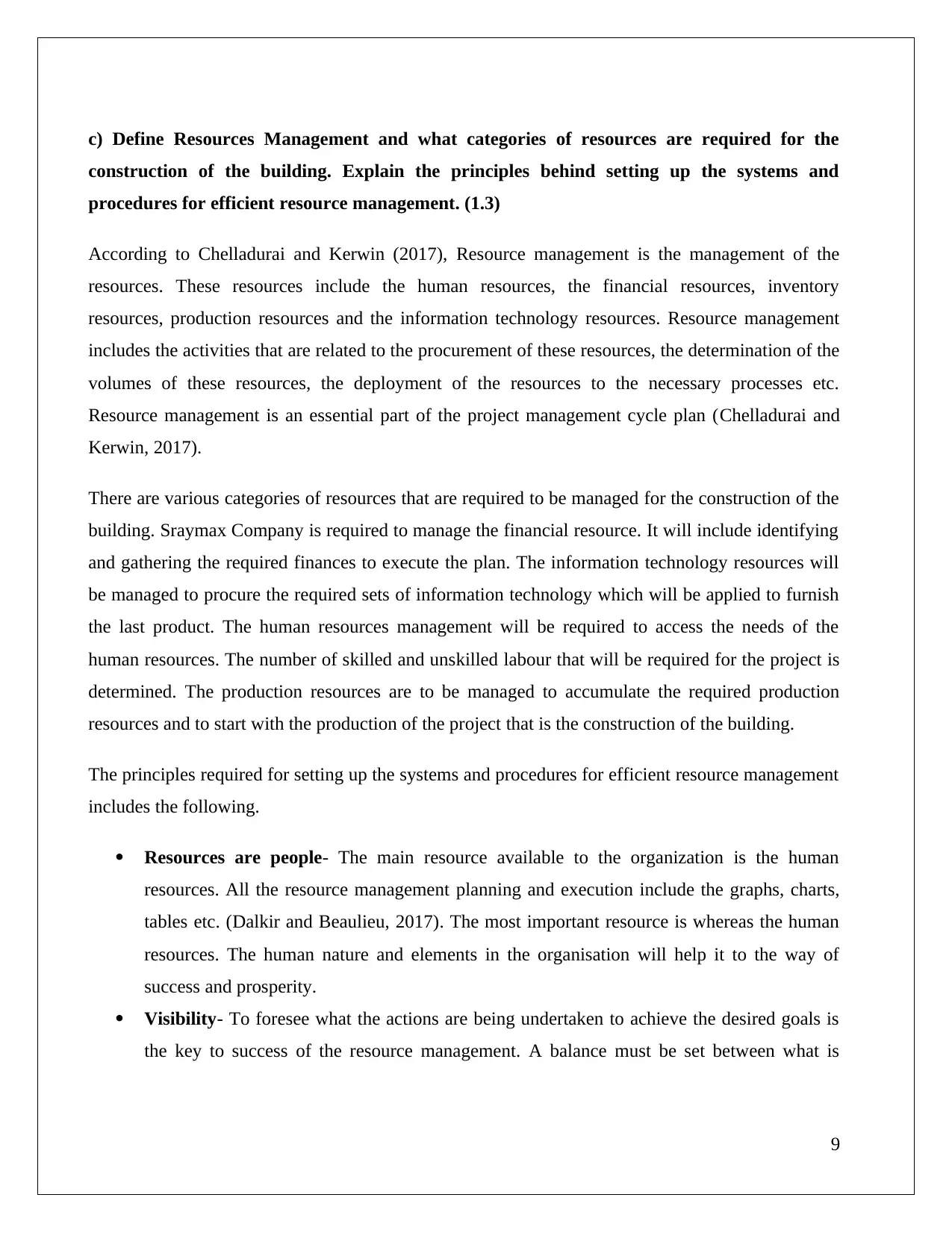
c) Define Resources Management and what categories of resources are required for the
construction of the building. Explain the principles behind setting up the systems and
procedures for efficient resource management. (1.3)
According to Chelladurai and Kerwin (2017), Resource management is the management of the
resources. These resources include the human resources, the financial resources, inventory
resources, production resources and the information technology resources. Resource management
includes the activities that are related to the procurement of these resources, the determination of the
volumes of these resources, the deployment of the resources to the necessary processes etc.
Resource management is an essential part of the project management cycle plan (Chelladurai and
Kerwin, 2017).
There are various categories of resources that are required to be managed for the construction of the
building. Sraymax Company is required to manage the financial resource. It will include identifying
and gathering the required finances to execute the plan. The information technology resources will
be managed to procure the required sets of information technology which will be applied to furnish
the last product. The human resources management will be required to access the needs of the
human resources. The number of skilled and unskilled labour that will be required for the project is
determined. The production resources are to be managed to accumulate the required production
resources and to start with the production of the project that is the construction of the building.
The principles required for setting up the systems and procedures for efficient resource management
includes the following.
Resources are people- The main resource available to the organization is the human
resources. All the resource management planning and execution include the graphs, charts,
tables etc. (Dalkir and Beaulieu, 2017). The most important resource is whereas the human
resources. The human nature and elements in the organisation will help it to the way of
success and prosperity.
Visibility- To foresee what the actions are being undertaken to achieve the desired goals is
the key to success of the resource management. A balance must be set between what is
9
construction of the building. Explain the principles behind setting up the systems and
procedures for efficient resource management. (1.3)
According to Chelladurai and Kerwin (2017), Resource management is the management of the
resources. These resources include the human resources, the financial resources, inventory
resources, production resources and the information technology resources. Resource management
includes the activities that are related to the procurement of these resources, the determination of the
volumes of these resources, the deployment of the resources to the necessary processes etc.
Resource management is an essential part of the project management cycle plan (Chelladurai and
Kerwin, 2017).
There are various categories of resources that are required to be managed for the construction of the
building. Sraymax Company is required to manage the financial resource. It will include identifying
and gathering the required finances to execute the plan. The information technology resources will
be managed to procure the required sets of information technology which will be applied to furnish
the last product. The human resources management will be required to access the needs of the
human resources. The number of skilled and unskilled labour that will be required for the project is
determined. The production resources are to be managed to accumulate the required production
resources and to start with the production of the project that is the construction of the building.
The principles required for setting up the systems and procedures for efficient resource management
includes the following.
Resources are people- The main resource available to the organization is the human
resources. All the resource management planning and execution include the graphs, charts,
tables etc. (Dalkir and Beaulieu, 2017). The most important resource is whereas the human
resources. The human nature and elements in the organisation will help it to the way of
success and prosperity.
Visibility- To foresee what the actions are being undertaken to achieve the desired goals is
the key to success of the resource management. A balance must be set between what is
9
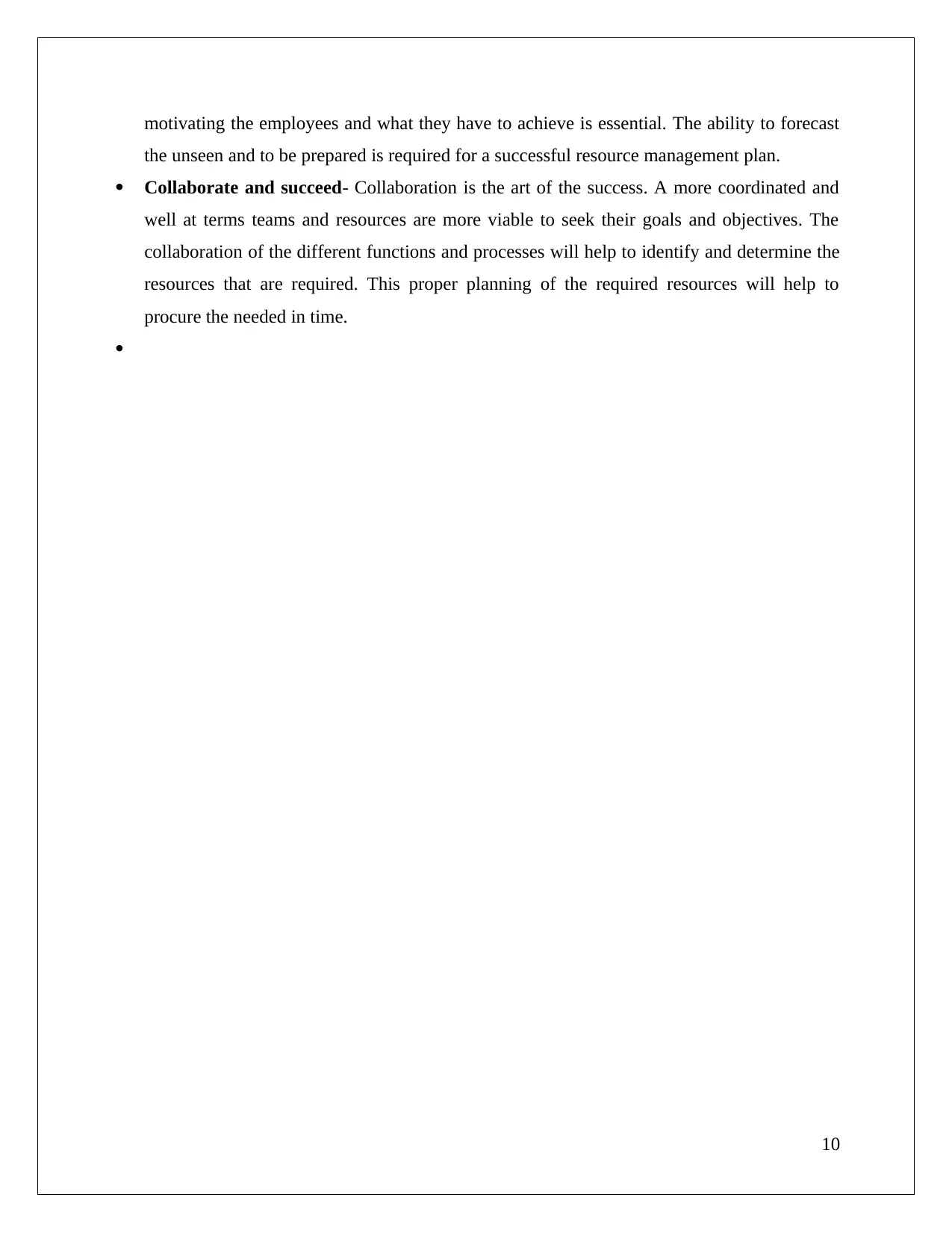
motivating the employees and what they have to achieve is essential. The ability to forecast
the unseen and to be prepared is required for a successful resource management plan.
Collaborate and succeed- Collaboration is the art of the success. A more coordinated and
well at terms teams and resources are more viable to seek their goals and objectives. The
collaboration of the different functions and processes will help to identify and determine the
resources that are required. This proper planning of the required resources will help to
procure the needed in time.
10
the unseen and to be prepared is required for a successful resource management plan.
Collaborate and succeed- Collaboration is the art of the success. A more coordinated and
well at terms teams and resources are more viable to seek their goals and objectives. The
collaboration of the different functions and processes will help to identify and determine the
resources that are required. This proper planning of the required resources will help to
procure the needed in time.
10
Paraphrase This Document
Need a fresh take? Get an instant paraphrase of this document with our AI Paraphraser
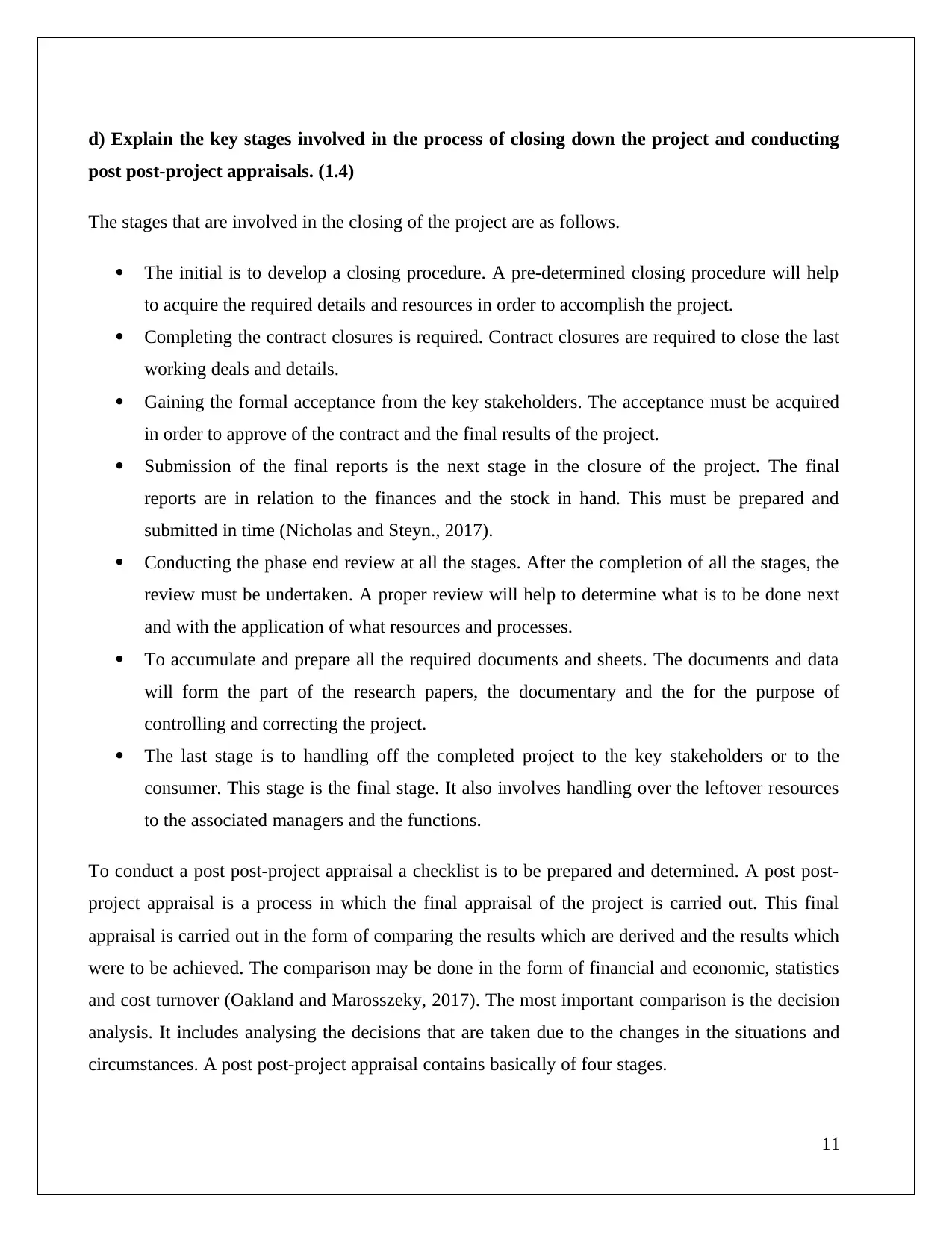
d) Explain the key stages involved in the process of closing down the project and conducting
post post-project appraisals. (1.4)
The stages that are involved in the closing of the project are as follows.
The initial is to develop a closing procedure. A pre-determined closing procedure will help
to acquire the required details and resources in order to accomplish the project.
Completing the contract closures is required. Contract closures are required to close the last
working deals and details.
Gaining the formal acceptance from the key stakeholders. The acceptance must be acquired
in order to approve of the contract and the final results of the project.
Submission of the final reports is the next stage in the closure of the project. The final
reports are in relation to the finances and the stock in hand. This must be prepared and
submitted in time (Nicholas and Steyn., 2017).
Conducting the phase end review at all the stages. After the completion of all the stages, the
review must be undertaken. A proper review will help to determine what is to be done next
and with the application of what resources and processes.
To accumulate and prepare all the required documents and sheets. The documents and data
will form the part of the research papers, the documentary and the for the purpose of
controlling and correcting the project.
The last stage is to handling off the completed project to the key stakeholders or to the
consumer. This stage is the final stage. It also involves handling over the leftover resources
to the associated managers and the functions.
To conduct a post post-project appraisal a checklist is to be prepared and determined. A post post-
project appraisal is a process in which the final appraisal of the project is carried out. This final
appraisal is carried out in the form of comparing the results which are derived and the results which
were to be achieved. The comparison may be done in the form of financial and economic, statistics
and cost turnover (Oakland and Marosszeky, 2017). The most important comparison is the decision
analysis. It includes analysing the decisions that are taken due to the changes in the situations and
circumstances. A post post-project appraisal contains basically of four stages.
11
post post-project appraisals. (1.4)
The stages that are involved in the closing of the project are as follows.
The initial is to develop a closing procedure. A pre-determined closing procedure will help
to acquire the required details and resources in order to accomplish the project.
Completing the contract closures is required. Contract closures are required to close the last
working deals and details.
Gaining the formal acceptance from the key stakeholders. The acceptance must be acquired
in order to approve of the contract and the final results of the project.
Submission of the final reports is the next stage in the closure of the project. The final
reports are in relation to the finances and the stock in hand. This must be prepared and
submitted in time (Nicholas and Steyn., 2017).
Conducting the phase end review at all the stages. After the completion of all the stages, the
review must be undertaken. A proper review will help to determine what is to be done next
and with the application of what resources and processes.
To accumulate and prepare all the required documents and sheets. The documents and data
will form the part of the research papers, the documentary and the for the purpose of
controlling and correcting the project.
The last stage is to handling off the completed project to the key stakeholders or to the
consumer. This stage is the final stage. It also involves handling over the leftover resources
to the associated managers and the functions.
To conduct a post post-project appraisal a checklist is to be prepared and determined. A post post-
project appraisal is a process in which the final appraisal of the project is carried out. This final
appraisal is carried out in the form of comparing the results which are derived and the results which
were to be achieved. The comparison may be done in the form of financial and economic, statistics
and cost turnover (Oakland and Marosszeky, 2017). The most important comparison is the decision
analysis. It includes analysing the decisions that are taken due to the changes in the situations and
circumstances. A post post-project appraisal contains basically of four stages.
11
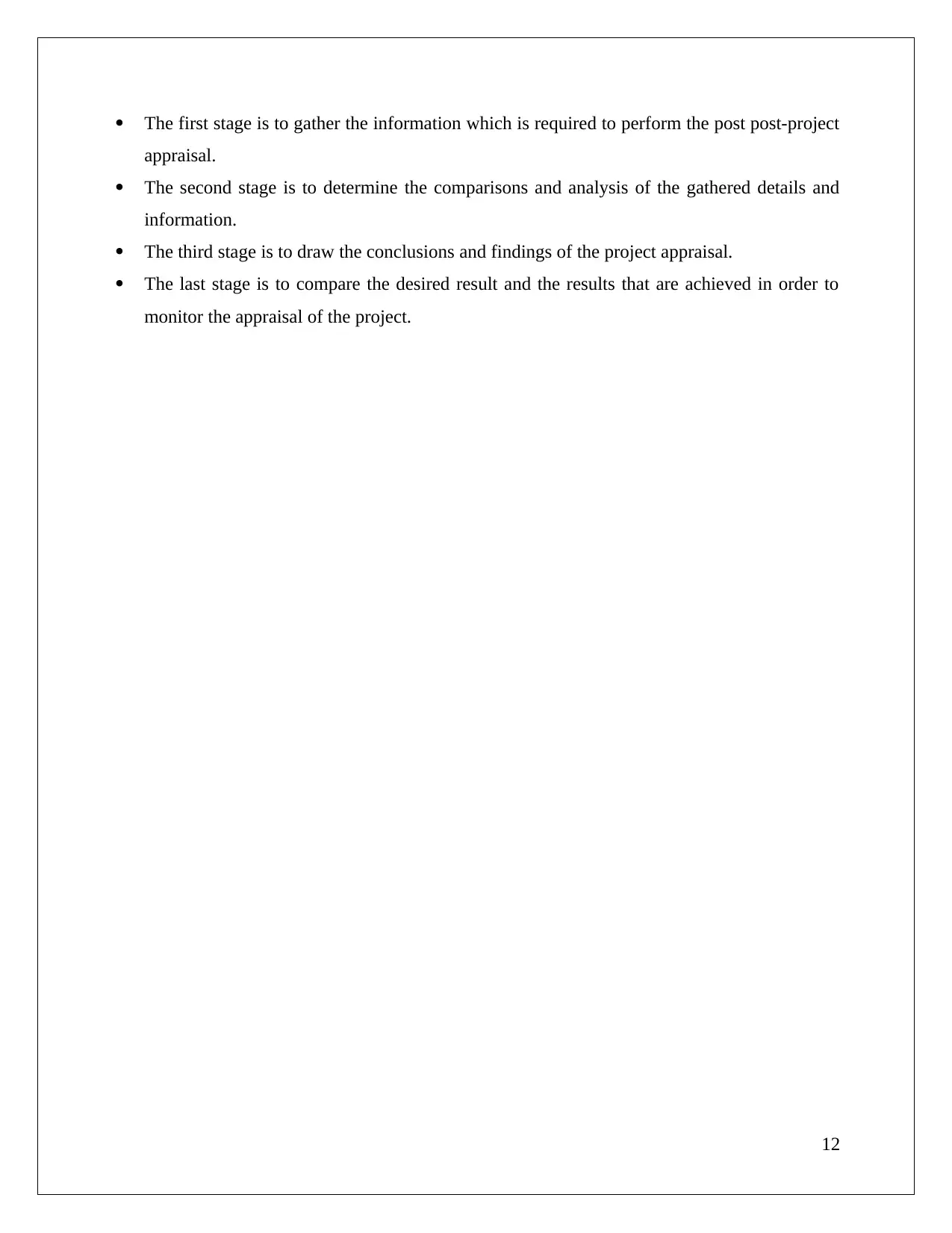
The first stage is to gather the information which is required to perform the post post-project
appraisal.
The second stage is to determine the comparisons and analysis of the gathered details and
information.
The third stage is to draw the conclusions and findings of the project appraisal.
The last stage is to compare the desired result and the results that are achieved in order to
monitor the appraisal of the project.
12
appraisal.
The second stage is to determine the comparisons and analysis of the gathered details and
information.
The third stage is to draw the conclusions and findings of the project appraisal.
The last stage is to compare the desired result and the results that are achieved in order to
monitor the appraisal of the project.
12

Task 2
a) Identify the most appropriate organisational structure, roles and responsibilities of
participants within the project. (2.1)
The organisational structure consists of the activities that define the work allocations, supervision of
the subordinates, superior-subordinate relationships, scalar chins, authority and responsibility in an
organization. An organizational structure may be a flat structure or matrix structure, functional
structure etc. The most appropriate organizational structure for this project will be a project
organization structure. A project organisation is a structure in which the activities are undertaken in
a form that facilities the harmonization and application of the tasks towards the fulfilment of the
project. Project organisation structure is developed in the projects to foster the interactions between
the team members and the associates. It facilities batter communication and develops the
understanding of the various teams working on a project (Bolman and Deal., 2017). It enables to
eliminate the ambiguity and distress in the project between the employees and the employers. The
structure has an advantage of representing the relationships between the different team members,
superior and subordinates graphically in the form of an organisational chart. The structure builds
such an open environment in the project which eases the activities that are to be monitored and
evaluated. Thus a project organisation is the most appropriate organisational structure for this
project.
The roles and responsibilities of the participants within the project can be described as below.
The project coordinator is the superior most manager or personnel. The project coordinator
is responsible for the supervision and the proper execution of the project. The coordinator
has to oversee the project activities and functions that are being executed towards the
furnishing of the project.
The project coordinator directly supervises the training coordinator and the accountant or the
administrator. The project coordinator is the topmost authority in the project organisation
and commands the final decision-making power and allocates the responsibilities and duties
to the whole organisation.
13
a) Identify the most appropriate organisational structure, roles and responsibilities of
participants within the project. (2.1)
The organisational structure consists of the activities that define the work allocations, supervision of
the subordinates, superior-subordinate relationships, scalar chins, authority and responsibility in an
organization. An organizational structure may be a flat structure or matrix structure, functional
structure etc. The most appropriate organizational structure for this project will be a project
organization structure. A project organisation is a structure in which the activities are undertaken in
a form that facilities the harmonization and application of the tasks towards the fulfilment of the
project. Project organisation structure is developed in the projects to foster the interactions between
the team members and the associates. It facilities batter communication and develops the
understanding of the various teams working on a project (Bolman and Deal., 2017). It enables to
eliminate the ambiguity and distress in the project between the employees and the employers. The
structure has an advantage of representing the relationships between the different team members,
superior and subordinates graphically in the form of an organisational chart. The structure builds
such an open environment in the project which eases the activities that are to be monitored and
evaluated. Thus a project organisation is the most appropriate organisational structure for this
project.
The roles and responsibilities of the participants within the project can be described as below.
The project coordinator is the superior most manager or personnel. The project coordinator
is responsible for the supervision and the proper execution of the project. The coordinator
has to oversee the project activities and functions that are being executed towards the
furnishing of the project.
The project coordinator directly supervises the training coordinator and the accountant or the
administrator. The project coordinator is the topmost authority in the project organisation
and commands the final decision-making power and allocates the responsibilities and duties
to the whole organisation.
13
Secure Best Marks with AI Grader
Need help grading? Try our AI Grader for instant feedback on your assignments.
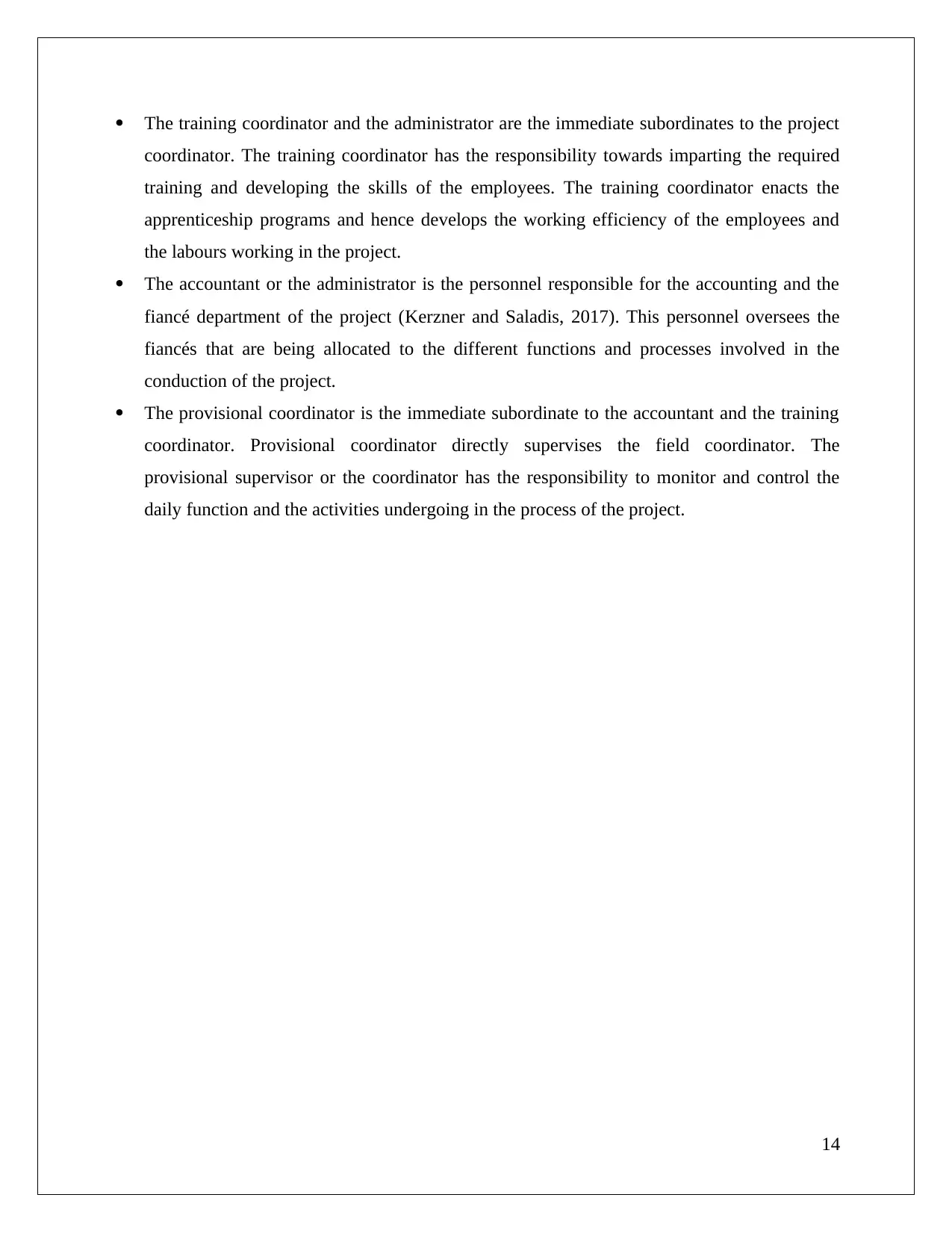
The training coordinator and the administrator are the immediate subordinates to the project
coordinator. The training coordinator has the responsibility towards imparting the required
training and developing the skills of the employees. The training coordinator enacts the
apprenticeship programs and hence develops the working efficiency of the employees and
the labours working in the project.
The accountant or the administrator is the personnel responsible for the accounting and the
fiancé department of the project (Kerzner and Saladis, 2017). This personnel oversees the
fiancés that are being allocated to the different functions and processes involved in the
conduction of the project.
The provisional coordinator is the immediate subordinate to the accountant and the training
coordinator. Provisional coordinator directly supervises the field coordinator. The
provisional supervisor or the coordinator has the responsibility to monitor and control the
daily function and the activities undergoing in the process of the project.
14
coordinator. The training coordinator has the responsibility towards imparting the required
training and developing the skills of the employees. The training coordinator enacts the
apprenticeship programs and hence develops the working efficiency of the employees and
the labours working in the project.
The accountant or the administrator is the personnel responsible for the accounting and the
fiancé department of the project (Kerzner and Saladis, 2017). This personnel oversees the
fiancés that are being allocated to the different functions and processes involved in the
conduction of the project.
The provisional coordinator is the immediate subordinate to the accountant and the training
coordinator. Provisional coordinator directly supervises the field coordinator. The
provisional supervisor or the coordinator has the responsibility to monitor and control the
daily function and the activities undergoing in the process of the project.
14
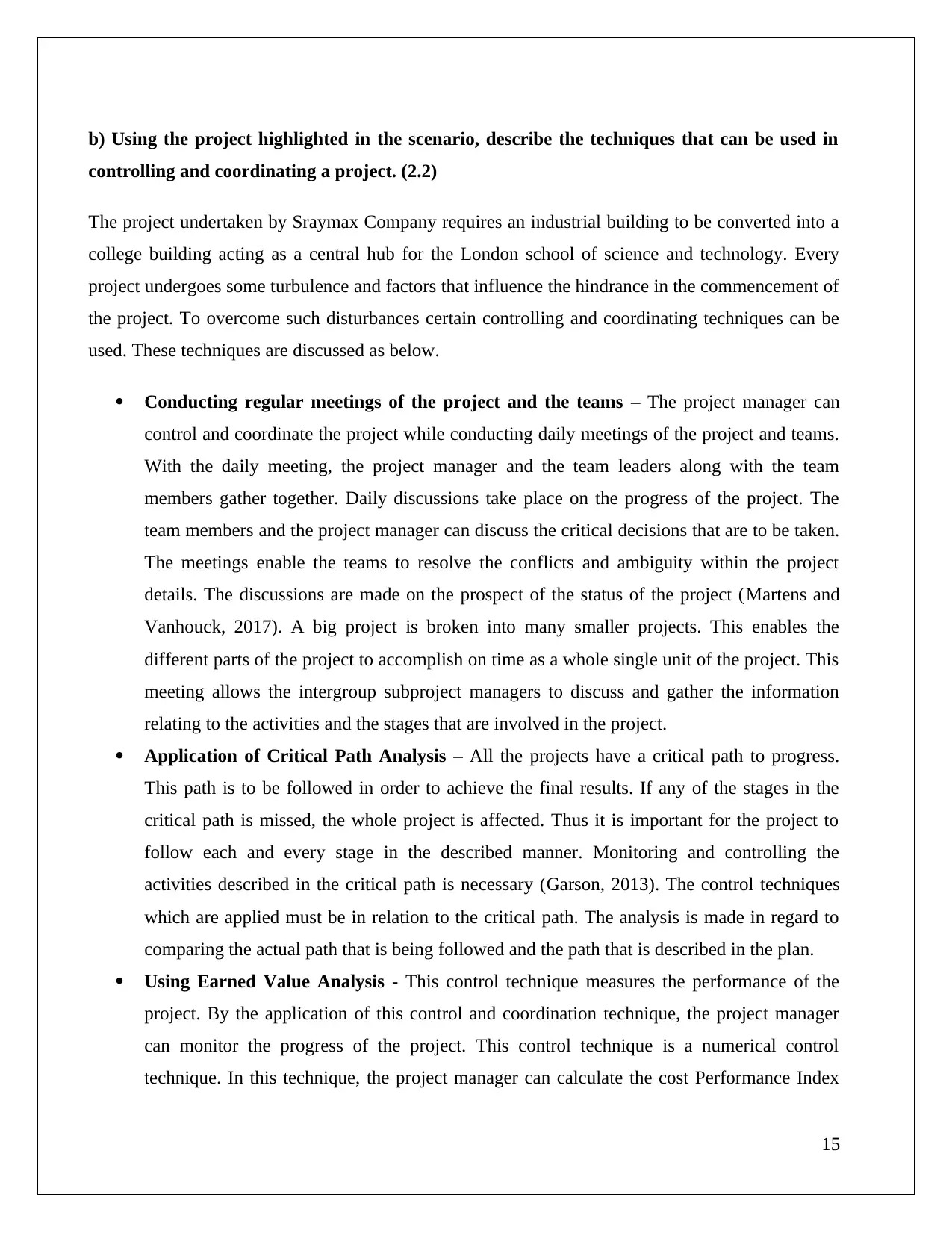
b) Using the project highlighted in the scenario, describe the techniques that can be used in
controlling and coordinating a project. (2.2)
The project undertaken by Sraymax Company requires an industrial building to be converted into a
college building acting as a central hub for the London school of science and technology. Every
project undergoes some turbulence and factors that influence the hindrance in the commencement of
the project. To overcome such disturbances certain controlling and coordinating techniques can be
used. These techniques are discussed as below.
Conducting regular meetings of the project and the teams – The project manager can
control and coordinate the project while conducting daily meetings of the project and teams.
With the daily meeting, the project manager and the team leaders along with the team
members gather together. Daily discussions take place on the progress of the project. The
team members and the project manager can discuss the critical decisions that are to be taken.
The meetings enable the teams to resolve the conflicts and ambiguity within the project
details. The discussions are made on the prospect of the status of the project (Martens and
Vanhouck, 2017). A big project is broken into many smaller projects. This enables the
different parts of the project to accomplish on time as a whole single unit of the project. This
meeting allows the intergroup subproject managers to discuss and gather the information
relating to the activities and the stages that are involved in the project.
Application of Critical Path Analysis – All the projects have a critical path to progress.
This path is to be followed in order to achieve the final results. If any of the stages in the
critical path is missed, the whole project is affected. Thus it is important for the project to
follow each and every stage in the described manner. Monitoring and controlling the
activities described in the critical path is necessary (Garson, 2013). The control techniques
which are applied must be in relation to the critical path. The analysis is made in regard to
comparing the actual path that is being followed and the path that is described in the plan.
Using Earned Value Analysis - This control technique measures the performance of the
project. By the application of this control and coordination technique, the project manager
can monitor the progress of the project. This control technique is a numerical control
technique. In this technique, the project manager can calculate the cost Performance Index
15
controlling and coordinating a project. (2.2)
The project undertaken by Sraymax Company requires an industrial building to be converted into a
college building acting as a central hub for the London school of science and technology. Every
project undergoes some turbulence and factors that influence the hindrance in the commencement of
the project. To overcome such disturbances certain controlling and coordinating techniques can be
used. These techniques are discussed as below.
Conducting regular meetings of the project and the teams – The project manager can
control and coordinate the project while conducting daily meetings of the project and teams.
With the daily meeting, the project manager and the team leaders along with the team
members gather together. Daily discussions take place on the progress of the project. The
team members and the project manager can discuss the critical decisions that are to be taken.
The meetings enable the teams to resolve the conflicts and ambiguity within the project
details. The discussions are made on the prospect of the status of the project (Martens and
Vanhouck, 2017). A big project is broken into many smaller projects. This enables the
different parts of the project to accomplish on time as a whole single unit of the project. This
meeting allows the intergroup subproject managers to discuss and gather the information
relating to the activities and the stages that are involved in the project.
Application of Critical Path Analysis – All the projects have a critical path to progress.
This path is to be followed in order to achieve the final results. If any of the stages in the
critical path is missed, the whole project is affected. Thus it is important for the project to
follow each and every stage in the described manner. Monitoring and controlling the
activities described in the critical path is necessary (Garson, 2013). The control techniques
which are applied must be in relation to the critical path. The analysis is made in regard to
comparing the actual path that is being followed and the path that is described in the plan.
Using Earned Value Analysis - This control technique measures the performance of the
project. By the application of this control and coordination technique, the project manager
can monitor the progress of the project. This control technique is a numerical control
technique. In this technique, the project manager can calculate the cost Performance Index
15
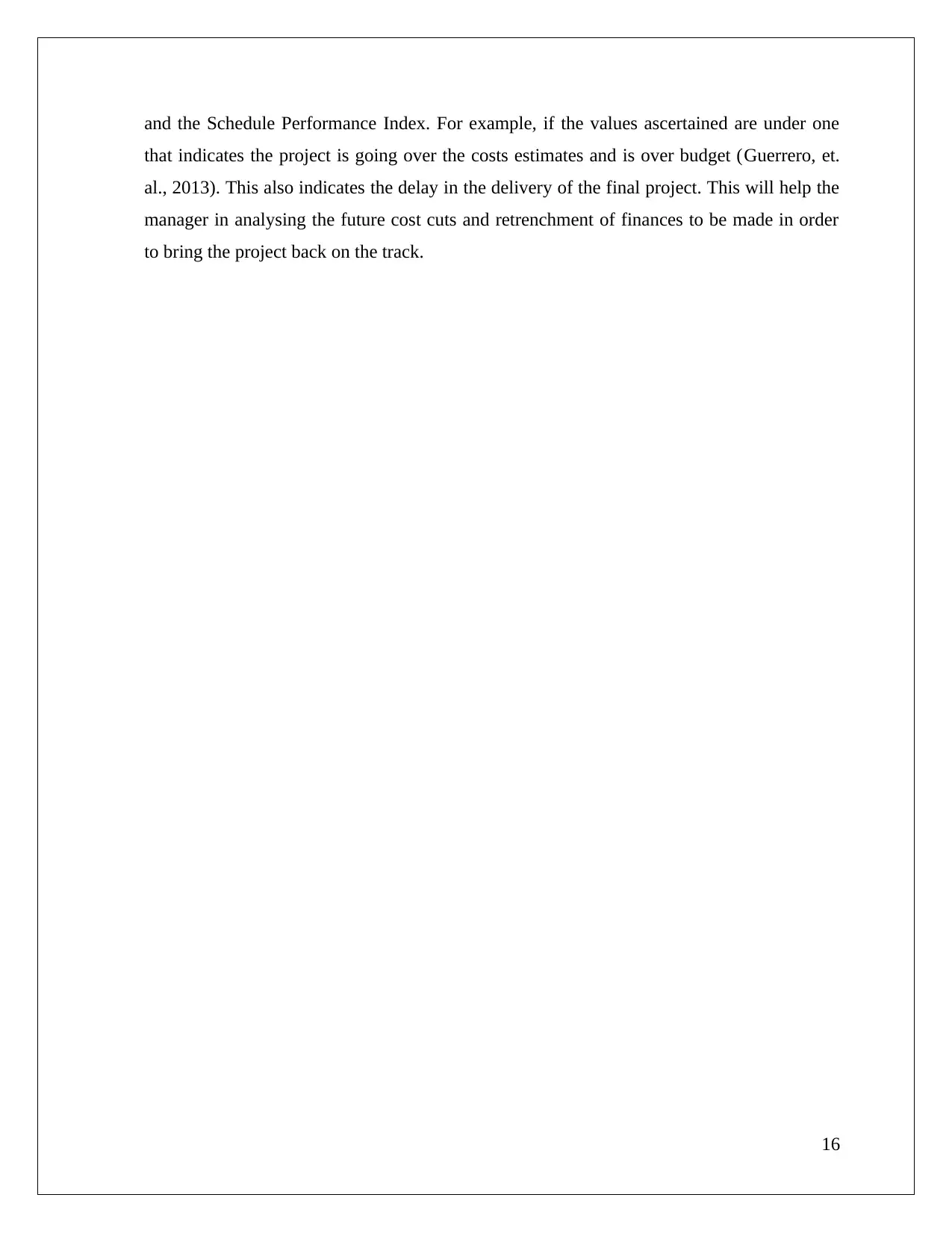
and the Schedule Performance Index. For example, if the values ascertained are under one
that indicates the project is going over the costs estimates and is over budget (Guerrero, et.
al., 2013). This also indicates the delay in the delivery of the final project. This will help the
manager in analysing the future cost cuts and retrenchment of finances to be made in order
to bring the project back on the track.
16
that indicates the project is going over the costs estimates and is over budget (Guerrero, et.
al., 2013). This also indicates the delay in the delivery of the final project. This will help the
manager in analysing the future cost cuts and retrenchment of finances to be made in order
to bring the project back on the track.
16
Paraphrase This Document
Need a fresh take? Get an instant paraphrase of this document with our AI Paraphraser
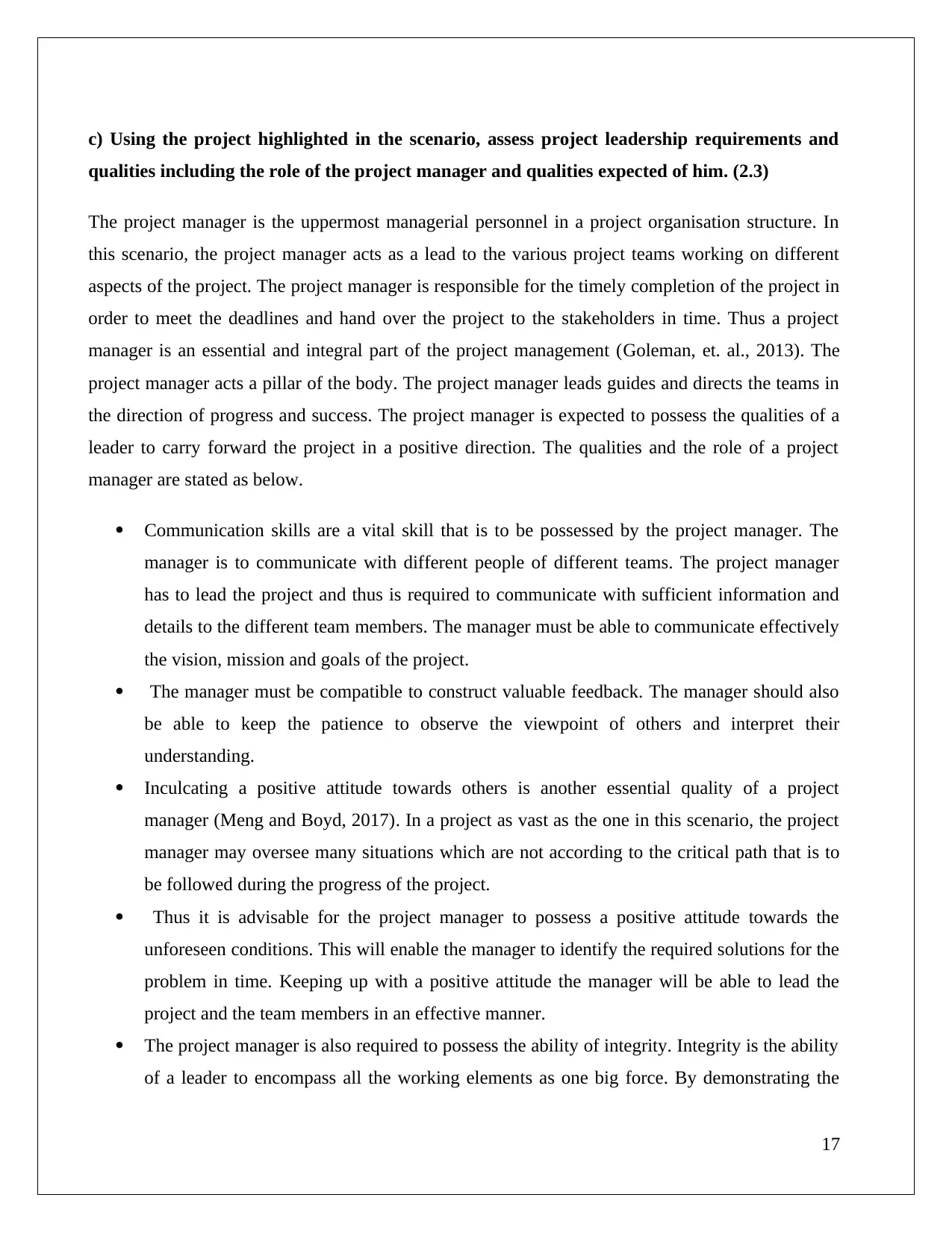
c) Using the project highlighted in the scenario, assess project leadership requirements and
qualities including the role of the project manager and qualities expected of him. (2.3)
The project manager is the uppermost managerial personnel in a project organisation structure. In
this scenario, the project manager acts as a lead to the various project teams working on different
aspects of the project. The project manager is responsible for the timely completion of the project in
order to meet the deadlines and hand over the project to the stakeholders in time. Thus a project
manager is an essential and integral part of the project management (Goleman, et. al., 2013). The
project manager acts a pillar of the body. The project manager leads guides and directs the teams in
the direction of progress and success. The project manager is expected to possess the qualities of a
leader to carry forward the project in a positive direction. The qualities and the role of a project
manager are stated as below.
Communication skills are a vital skill that is to be possessed by the project manager. The
manager is to communicate with different people of different teams. The project manager
has to lead the project and thus is required to communicate with sufficient information and
details to the different team members. The manager must be able to communicate effectively
the vision, mission and goals of the project.
The manager must be compatible to construct valuable feedback. The manager should also
be able to keep the patience to observe the viewpoint of others and interpret their
understanding.
Inculcating a positive attitude towards others is another essential quality of a project
manager (Meng and Boyd, 2017). In a project as vast as the one in this scenario, the project
manager may oversee many situations which are not according to the critical path that is to
be followed during the progress of the project.
Thus it is advisable for the project manager to possess a positive attitude towards the
unforeseen conditions. This will enable the manager to identify the required solutions for the
problem in time. Keeping up with a positive attitude the manager will be able to lead the
project and the team members in an effective manner.
The project manager is also required to possess the ability of integrity. Integrity is the ability
of a leader to encompass all the working elements as one big force. By demonstrating the
17
qualities including the role of the project manager and qualities expected of him. (2.3)
The project manager is the uppermost managerial personnel in a project organisation structure. In
this scenario, the project manager acts as a lead to the various project teams working on different
aspects of the project. The project manager is responsible for the timely completion of the project in
order to meet the deadlines and hand over the project to the stakeholders in time. Thus a project
manager is an essential and integral part of the project management (Goleman, et. al., 2013). The
project manager acts a pillar of the body. The project manager leads guides and directs the teams in
the direction of progress and success. The project manager is expected to possess the qualities of a
leader to carry forward the project in a positive direction. The qualities and the role of a project
manager are stated as below.
Communication skills are a vital skill that is to be possessed by the project manager. The
manager is to communicate with different people of different teams. The project manager
has to lead the project and thus is required to communicate with sufficient information and
details to the different team members. The manager must be able to communicate effectively
the vision, mission and goals of the project.
The manager must be compatible to construct valuable feedback. The manager should also
be able to keep the patience to observe the viewpoint of others and interpret their
understanding.
Inculcating a positive attitude towards others is another essential quality of a project
manager (Meng and Boyd, 2017). In a project as vast as the one in this scenario, the project
manager may oversee many situations which are not according to the critical path that is to
be followed during the progress of the project.
Thus it is advisable for the project manager to possess a positive attitude towards the
unforeseen conditions. This will enable the manager to identify the required solutions for the
problem in time. Keeping up with a positive attitude the manager will be able to lead the
project and the team members in an effective manner.
The project manager is also required to possess the ability of integrity. Integrity is the ability
of a leader to encompass all the working elements as one big force. By demonstrating the
17
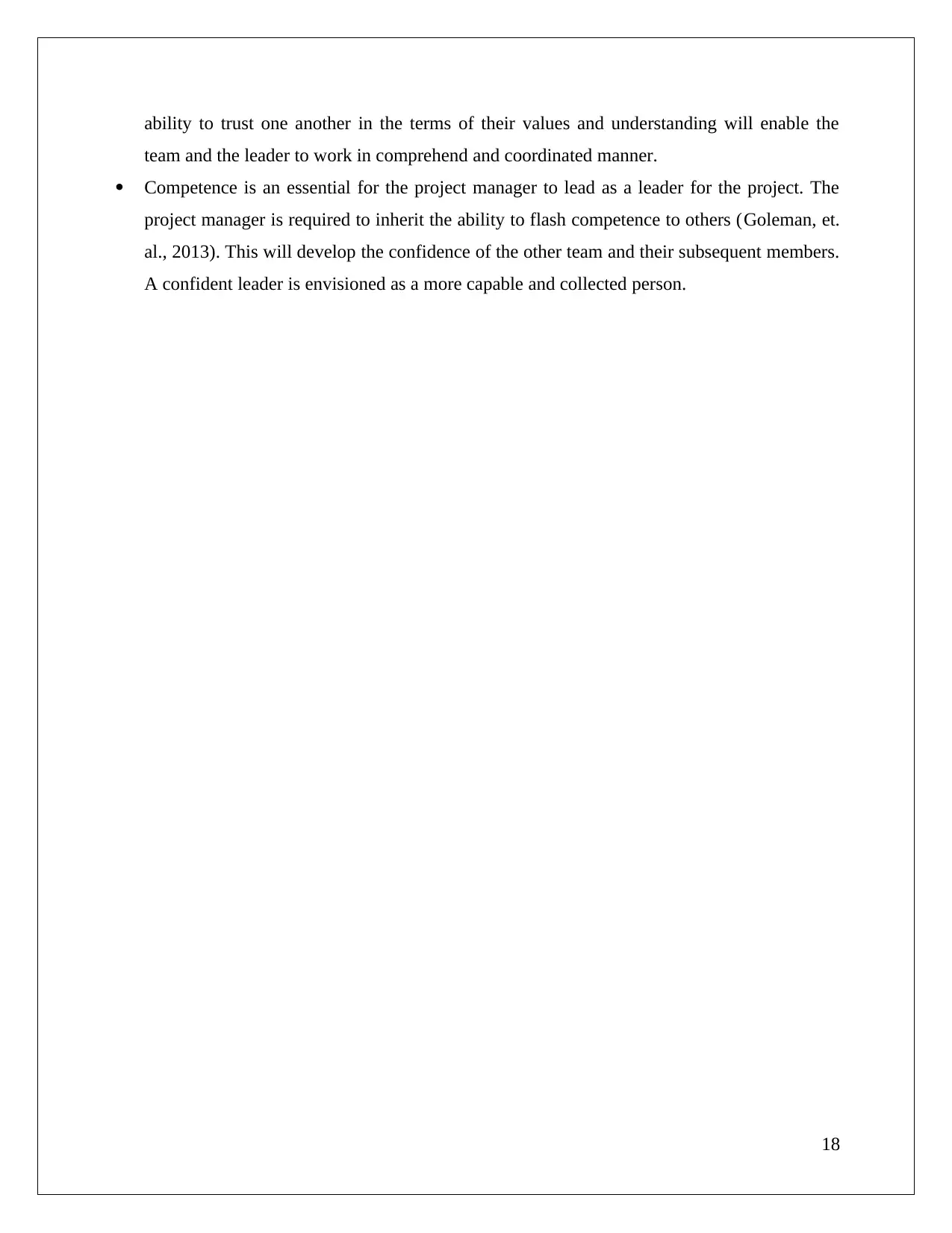
ability to trust one another in the terms of their values and understanding will enable the
team and the leader to work in comprehend and coordinated manner.
Competence is an essential for the project manager to lead as a leader for the project. The
project manager is required to inherit the ability to flash competence to others (Goleman, et.
al., 2013). This will develop the confidence of the other team and their subsequent members.
A confident leader is envisioned as a more capable and collected person.
18
team and the leader to work in comprehend and coordinated manner.
Competence is an essential for the project manager to lead as a leader for the project. The
project manager is required to inherit the ability to flash competence to others (Goleman, et.
al., 2013). This will develop the confidence of the other team and their subsequent members.
A confident leader is envisioned as a more capable and collected person.
18
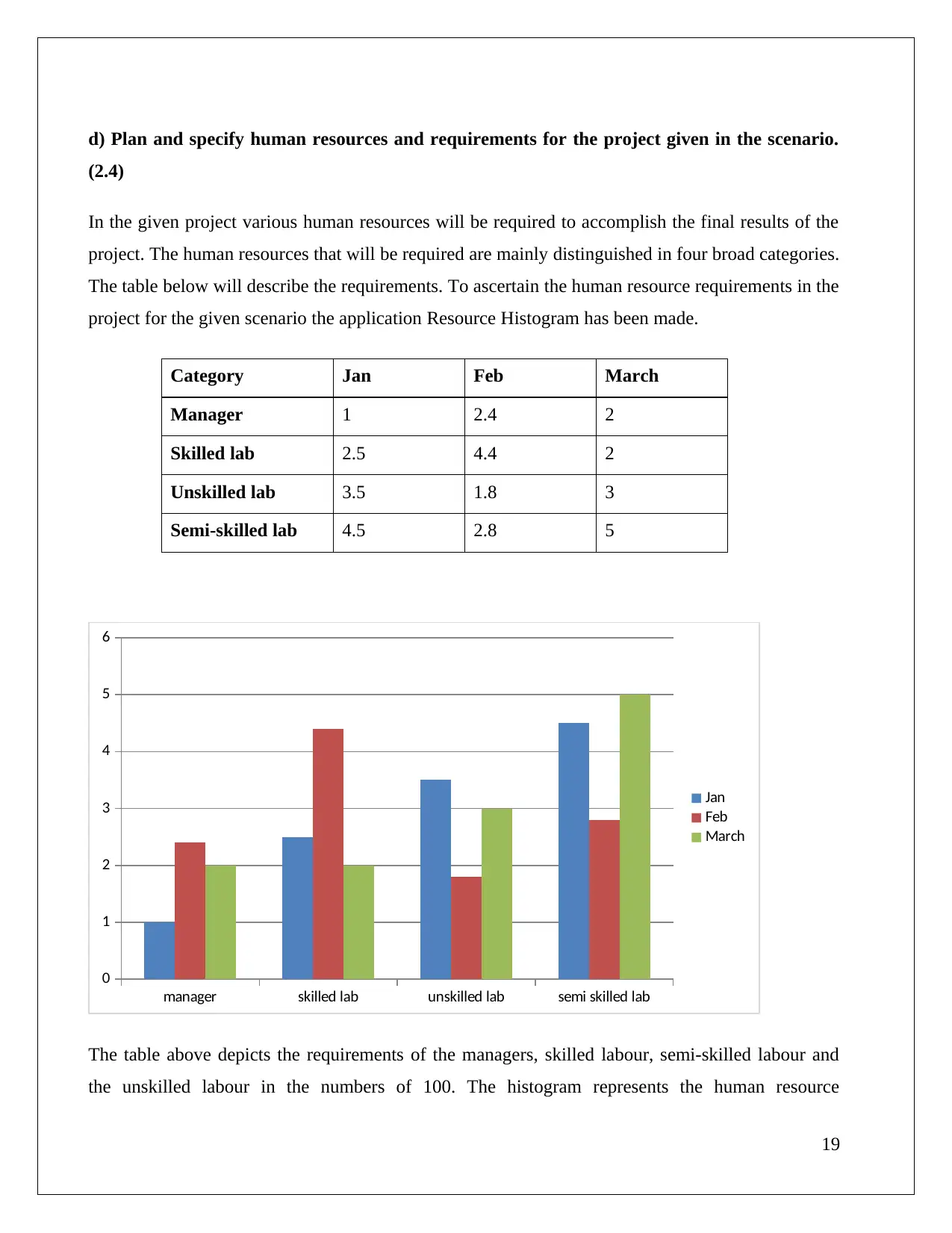
d) Plan and specify human resources and requirements for the project given in the scenario.
(2.4)
In the given project various human resources will be required to accomplish the final results of the
project. The human resources that will be required are mainly distinguished in four broad categories.
The table below will describe the requirements. To ascertain the human resource requirements in the
project for the given scenario the application Resource Histogram has been made.
Category Jan Feb March
Manager 1 2.4 2
Skilled lab 2.5 4.4 2
Unskilled lab 3.5 1.8 3
Semi-skilled lab 4.5 2.8 5
manager skilled lab unskilled lab semi skilled lab
0
1
2
3
4
5
6
Jan
Feb
March
The table above depicts the requirements of the managers, skilled labour, semi-skilled labour and
the unskilled labour in the numbers of 100. The histogram represents the human resource
19
(2.4)
In the given project various human resources will be required to accomplish the final results of the
project. The human resources that will be required are mainly distinguished in four broad categories.
The table below will describe the requirements. To ascertain the human resource requirements in the
project for the given scenario the application Resource Histogram has been made.
Category Jan Feb March
Manager 1 2.4 2
Skilled lab 2.5 4.4 2
Unskilled lab 3.5 1.8 3
Semi-skilled lab 4.5 2.8 5
manager skilled lab unskilled lab semi skilled lab
0
1
2
3
4
5
6
Jan
Feb
March
The table above depicts the requirements of the managers, skilled labour, semi-skilled labour and
the unskilled labour in the numbers of 100. The histogram represents the human resource
19
Secure Best Marks with AI Grader
Need help grading? Try our AI Grader for instant feedback on your assignments.

requirements for the time duration of six months. The duration starting from January ends in March.
The types of human resources required as described as below.
The managers are required to monitor and control the project and its progress. The managers
will ascertain the progress of the project by identifying the various activities conducted in
the project. The managers act as the superiors in the scalar chain to the employees and the
labours.
The skilled labour will be required to perform the part and areas of the project that requires
some specific knowledge and expertise (Armstrong and Taylor., 2014). The skilled labour
will basically perform the activities involving the information technology. The skilled labour
will perform their tasks of installing the required furniture and other materials in the project.
The unskilled labour will be required at the onset of the project. The unskilled labour will
perform the tasks involving the basic construction activities, procuring the basic material for
fuelling the process of construction. The unskilled labour will have their role in act till the
building is developed and constructed according to the critical path that is to be followed.
The semi-skilled labour will act as the intermediary between the skilled and the unskilled
labour. The semi-skilled labour will guide to transfer the knowledge from the skilled
informative labour to the unskilled labour (Kavanagh and Johnson, 2017). Their main aim
will be to guide the unskilled labour in the critical areas involving some sort of expertise.
20
The types of human resources required as described as below.
The managers are required to monitor and control the project and its progress. The managers
will ascertain the progress of the project by identifying the various activities conducted in
the project. The managers act as the superiors in the scalar chain to the employees and the
labours.
The skilled labour will be required to perform the part and areas of the project that requires
some specific knowledge and expertise (Armstrong and Taylor., 2014). The skilled labour
will basically perform the activities involving the information technology. The skilled labour
will perform their tasks of installing the required furniture and other materials in the project.
The unskilled labour will be required at the onset of the project. The unskilled labour will
perform the tasks involving the basic construction activities, procuring the basic material for
fuelling the process of construction. The unskilled labour will have their role in act till the
building is developed and constructed according to the critical path that is to be followed.
The semi-skilled labour will act as the intermediary between the skilled and the unskilled
labour. The semi-skilled labour will guide to transfer the knowledge from the skilled
informative labour to the unskilled labour (Kavanagh and Johnson, 2017). Their main aim
will be to guide the unskilled labour in the critical areas involving some sort of expertise.
20
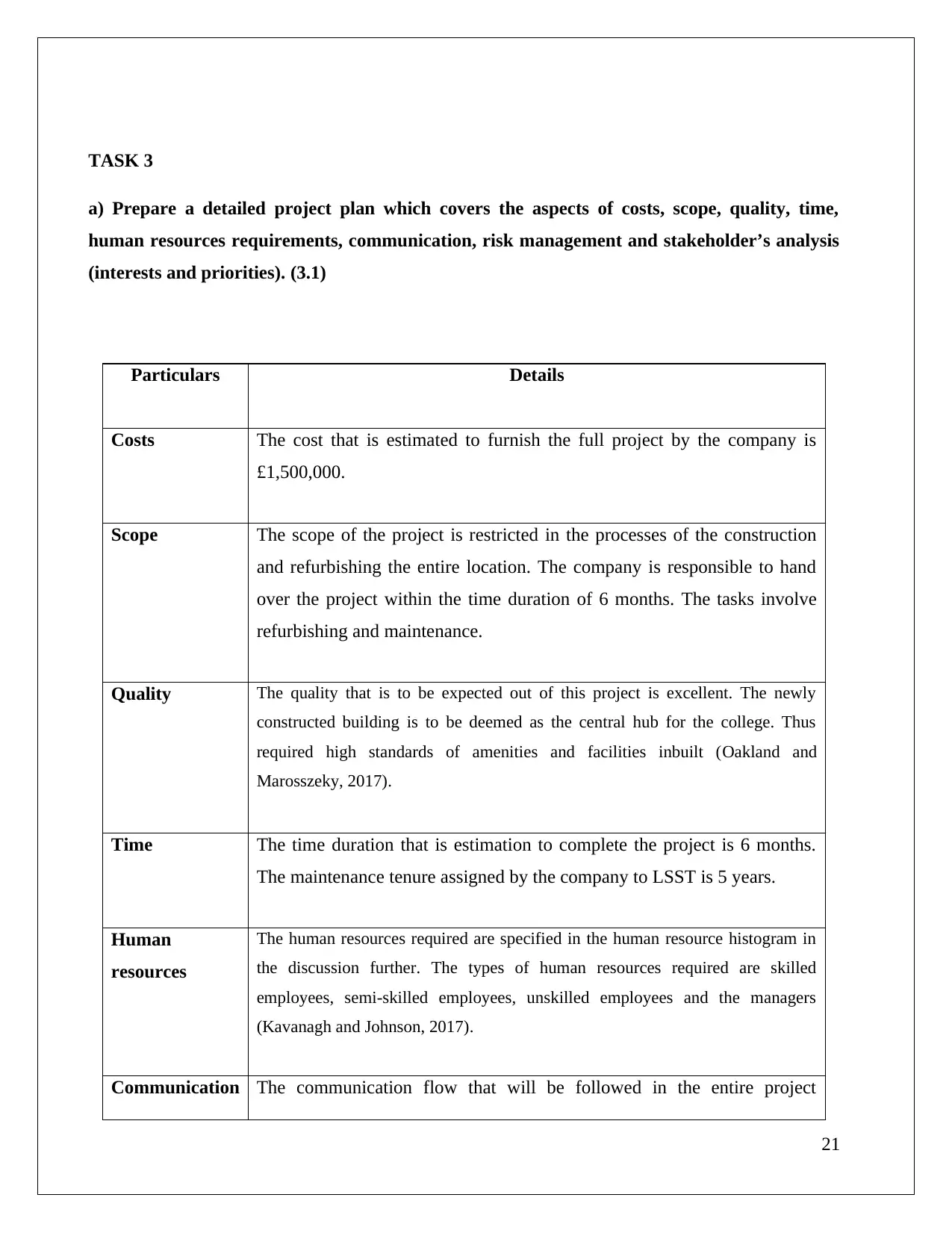
TASK 3
a) Prepare a detailed project plan which covers the aspects of costs, scope, quality, time,
human resources requirements, communication, risk management and stakeholder’s analysis
(interests and priorities). (3.1)
Particulars Details
Costs The cost that is estimated to furnish the full project by the company is
£1,500,000.
Scope The scope of the project is restricted in the processes of the construction
and refurbishing the entire location. The company is responsible to hand
over the project within the time duration of 6 months. The tasks involve
refurbishing and maintenance.
Quality The quality that is to be expected out of this project is excellent. The newly
constructed building is to be deemed as the central hub for the college. Thus
required high standards of amenities and facilities inbuilt (Oakland and
Marosszeky, 2017).
Time The time duration that is estimation to complete the project is 6 months.
The maintenance tenure assigned by the company to LSST is 5 years.
Human
resources
The human resources required are specified in the human resource histogram in
the discussion further. The types of human resources required are skilled
employees, semi-skilled employees, unskilled employees and the managers
(Kavanagh and Johnson, 2017).
Communication The communication flow that will be followed in the entire project
21
a) Prepare a detailed project plan which covers the aspects of costs, scope, quality, time,
human resources requirements, communication, risk management and stakeholder’s analysis
(interests and priorities). (3.1)
Particulars Details
Costs The cost that is estimated to furnish the full project by the company is
£1,500,000.
Scope The scope of the project is restricted in the processes of the construction
and refurbishing the entire location. The company is responsible to hand
over the project within the time duration of 6 months. The tasks involve
refurbishing and maintenance.
Quality The quality that is to be expected out of this project is excellent. The newly
constructed building is to be deemed as the central hub for the college. Thus
required high standards of amenities and facilities inbuilt (Oakland and
Marosszeky, 2017).
Time The time duration that is estimation to complete the project is 6 months.
The maintenance tenure assigned by the company to LSST is 5 years.
Human
resources
The human resources required are specified in the human resource histogram in
the discussion further. The types of human resources required are skilled
employees, semi-skilled employees, unskilled employees and the managers
(Kavanagh and Johnson, 2017).
Communication The communication flow that will be followed in the entire project
21

management cycle will be circle network.
Risk
management
Risk management is the ability to identify, evaluate, assess and solve the
uncertain situation in the tenure of the project (Esposito, et. al., 2017). The risk
management technique that will be applied in this project will be diversification
and loss prevention techniques.
Stakeholders
analysis
Stakeholder’s analysis is the process by which the relevant details are
gathered about whose interest is to be set on priority when applying a
certain policy or a program in the project management cycle. The take
holders having more than 65% of the share will be set on priority in this
project.
22
Risk
management
Risk management is the ability to identify, evaluate, assess and solve the
uncertain situation in the tenure of the project (Esposito, et. al., 2017). The risk
management technique that will be applied in this project will be diversification
and loss prevention techniques.
Stakeholders
analysis
Stakeholder’s analysis is the process by which the relevant details are
gathered about whose interest is to be set on priority when applying a
certain policy or a program in the project management cycle. The take
holders having more than 65% of the share will be set on priority in this
project.
22
Paraphrase This Document
Need a fresh take? Get an instant paraphrase of this document with our AI Paraphraser
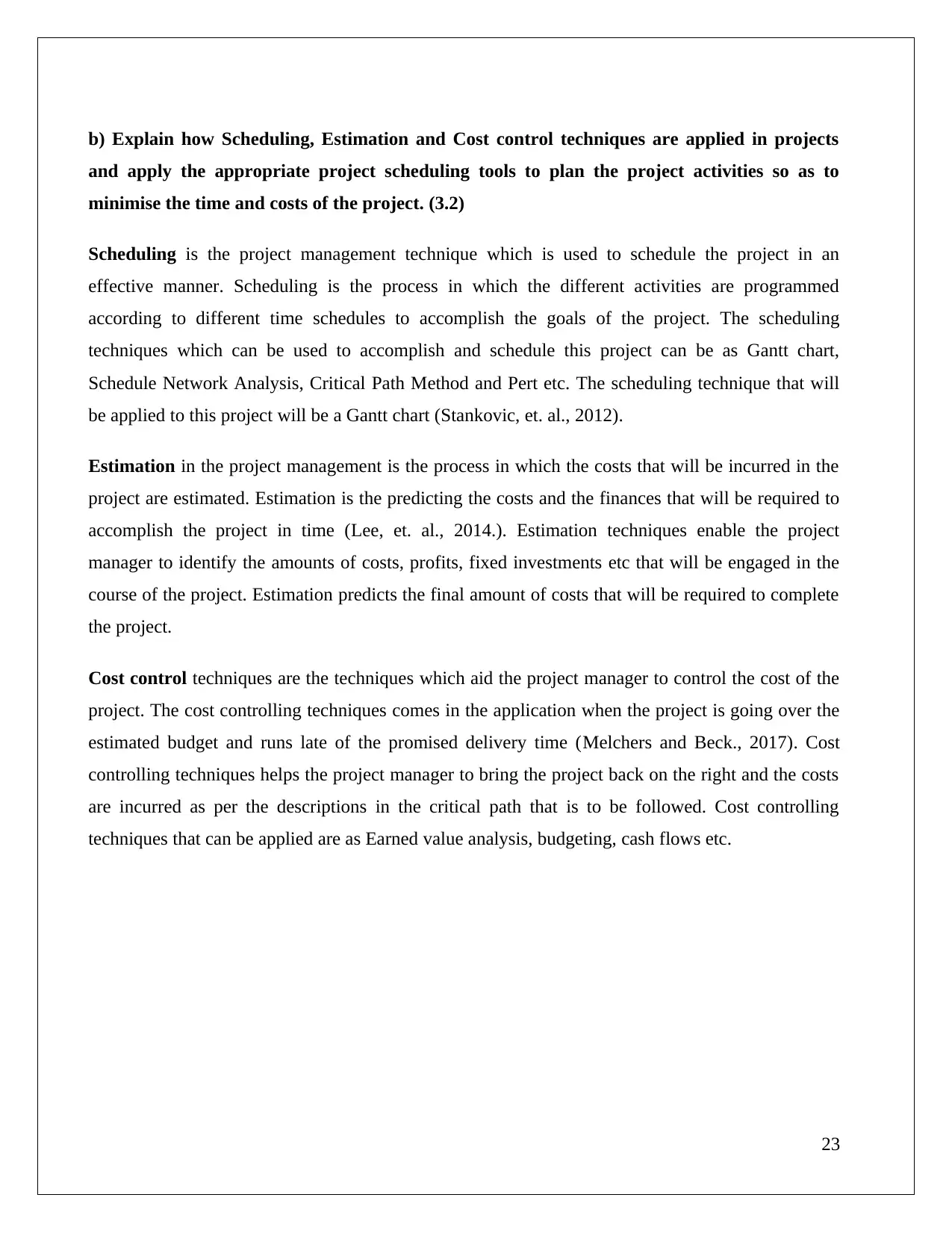
b) Explain how Scheduling, Estimation and Cost control techniques are applied in projects
and apply the appropriate project scheduling tools to plan the project activities so as to
minimise the time and costs of the project. (3.2)
Scheduling is the project management technique which is used to schedule the project in an
effective manner. Scheduling is the process in which the different activities are programmed
according to different time schedules to accomplish the goals of the project. The scheduling
techniques which can be used to accomplish and schedule this project can be as Gantt chart,
Schedule Network Analysis, Critical Path Method and Pert etc. The scheduling technique that will
be applied to this project will be a Gantt chart (Stankovic, et. al., 2012).
Estimation in the project management is the process in which the costs that will be incurred in the
project are estimated. Estimation is the predicting the costs and the finances that will be required to
accomplish the project in time (Lee, et. al., 2014.). Estimation techniques enable the project
manager to identify the amounts of costs, profits, fixed investments etc that will be engaged in the
course of the project. Estimation predicts the final amount of costs that will be required to complete
the project.
Cost control techniques are the techniques which aid the project manager to control the cost of the
project. The cost controlling techniques comes in the application when the project is going over the
estimated budget and runs late of the promised delivery time (Melchers and Beck., 2017). Cost
controlling techniques helps the project manager to bring the project back on the right and the costs
are incurred as per the descriptions in the critical path that is to be followed. Cost controlling
techniques that can be applied are as Earned value analysis, budgeting, cash flows etc.
23
and apply the appropriate project scheduling tools to plan the project activities so as to
minimise the time and costs of the project. (3.2)
Scheduling is the project management technique which is used to schedule the project in an
effective manner. Scheduling is the process in which the different activities are programmed
according to different time schedules to accomplish the goals of the project. The scheduling
techniques which can be used to accomplish and schedule this project can be as Gantt chart,
Schedule Network Analysis, Critical Path Method and Pert etc. The scheduling technique that will
be applied to this project will be a Gantt chart (Stankovic, et. al., 2012).
Estimation in the project management is the process in which the costs that will be incurred in the
project are estimated. Estimation is the predicting the costs and the finances that will be required to
accomplish the project in time (Lee, et. al., 2014.). Estimation techniques enable the project
manager to identify the amounts of costs, profits, fixed investments etc that will be engaged in the
course of the project. Estimation predicts the final amount of costs that will be required to complete
the project.
Cost control techniques are the techniques which aid the project manager to control the cost of the
project. The cost controlling techniques comes in the application when the project is going over the
estimated budget and runs late of the promised delivery time (Melchers and Beck., 2017). Cost
controlling techniques helps the project manager to bring the project back on the right and the costs
are incurred as per the descriptions in the critical path that is to be followed. Cost controlling
techniques that can be applied are as Earned value analysis, budgeting, cash flows etc.
23

Gantt chart
Task name Start Day End Day Duration (Week)
Planning 1 15.01.2018 2
Building Layout 16.01.2018 29.01.2018 2
Foundations 30.01.2018 26.02.2018 4
Structure formation 27.02.2018 26.03.2018 4
Exterior Finishing 27.03.2018 07.05.2018 6
Interior Finishing 8.05.2018 11.06.2018 5
Final Touch 12.06.2018 18.06.2018 1
24
Task name Start Day End Day Duration (Week)
Planning 1 15.01.2018 2
Building Layout 16.01.2018 29.01.2018 2
Foundations 30.01.2018 26.02.2018 4
Structure formation 27.02.2018 26.03.2018 4
Exterior Finishing 27.03.2018 07.05.2018 6
Interior Finishing 8.05.2018 11.06.2018 5
Final Touch 12.06.2018 18.06.2018 1
24

Activities Duration (In Weeks)
1 2 3 4 5 6 7 8 9
1
0
1
1
1
2
1
3
1
4
1
5
1
6
1
7
1
8
1
9
2
0
2
1
2
2
2
3
2
4
Planning
Building
Layout
Foundati
ons
Structure
formatio
n
Exterior
Finishing
Interior
Finishing
Final
Touch
25
1 2 3 4 5 6 7 8 9
1
0
1
1
1
2
1
3
1
4
1
5
1
6
1
7
1
8
1
9
2
0
2
1
2
2
2
3
2
4
Planning
Building
Layout
Foundati
ons
Structure
formatio
n
Exterior
Finishing
Interior
Finishing
Final
Touch
25
Secure Best Marks with AI Grader
Need help grading? Try our AI Grader for instant feedback on your assignments.
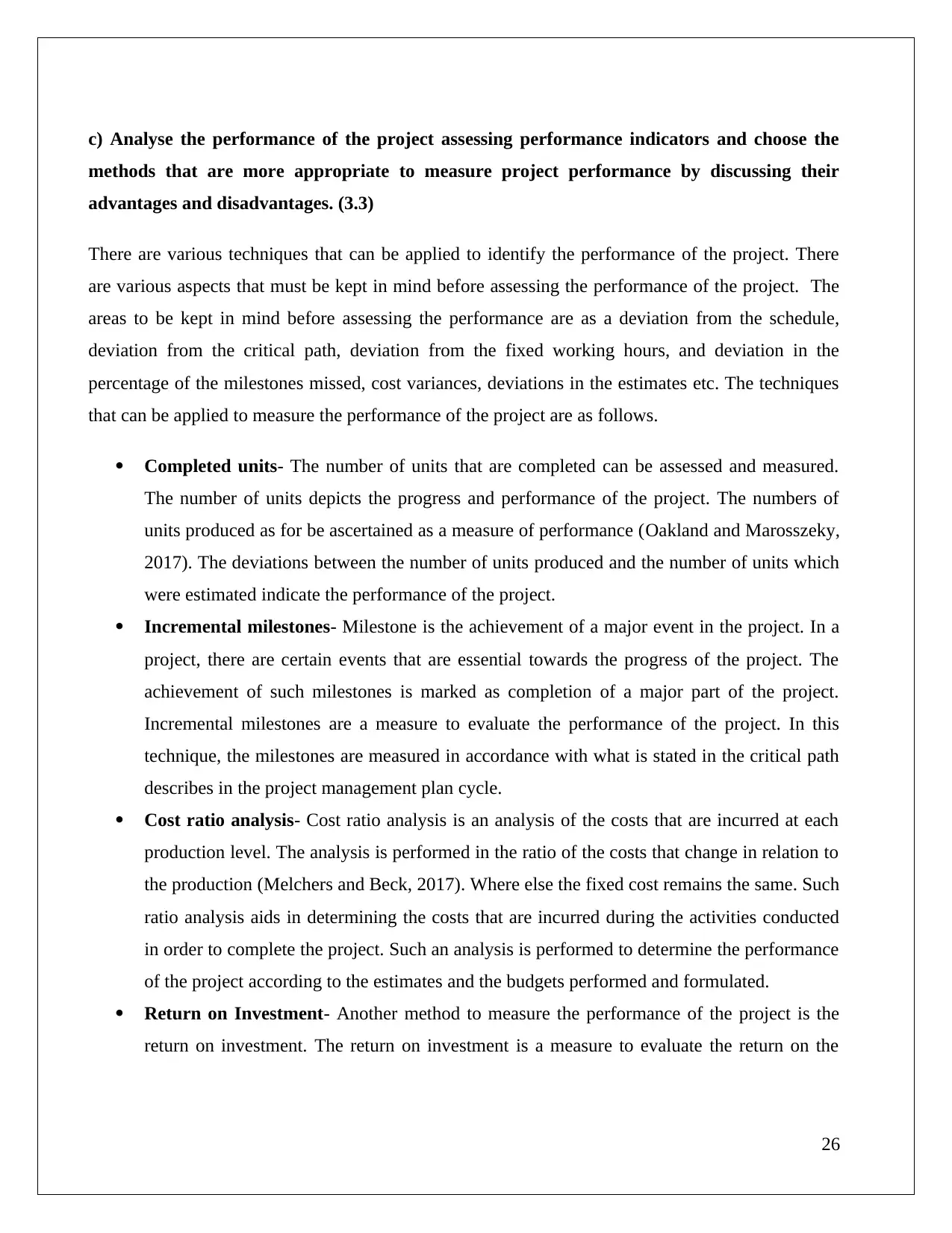
c) Analyse the performance of the project assessing performance indicators and choose the
methods that are more appropriate to measure project performance by discussing their
advantages and disadvantages. (3.3)
There are various techniques that can be applied to identify the performance of the project. There
are various aspects that must be kept in mind before assessing the performance of the project. The
areas to be kept in mind before assessing the performance are as a deviation from the schedule,
deviation from the critical path, deviation from the fixed working hours, and deviation in the
percentage of the milestones missed, cost variances, deviations in the estimates etc. The techniques
that can be applied to measure the performance of the project are as follows.
Completed units- The number of units that are completed can be assessed and measured.
The number of units depicts the progress and performance of the project. The numbers of
units produced as for be ascertained as a measure of performance (Oakland and Marosszeky,
2017). The deviations between the number of units produced and the number of units which
were estimated indicate the performance of the project.
Incremental milestones- Milestone is the achievement of a major event in the project. In a
project, there are certain events that are essential towards the progress of the project. The
achievement of such milestones is marked as completion of a major part of the project.
Incremental milestones are a measure to evaluate the performance of the project. In this
technique, the milestones are measured in accordance with what is stated in the critical path
describes in the project management plan cycle.
Cost ratio analysis- Cost ratio analysis is an analysis of the costs that are incurred at each
production level. The analysis is performed in the ratio of the costs that change in relation to
the production (Melchers and Beck, 2017). Where else the fixed cost remains the same. Such
ratio analysis aids in determining the costs that are incurred during the activities conducted
in order to complete the project. Such an analysis is performed to determine the performance
of the project according to the estimates and the budgets performed and formulated.
Return on Investment- Another method to measure the performance of the project is the
return on investment. The return on investment is a measure to evaluate the return on the
26
methods that are more appropriate to measure project performance by discussing their
advantages and disadvantages. (3.3)
There are various techniques that can be applied to identify the performance of the project. There
are various aspects that must be kept in mind before assessing the performance of the project. The
areas to be kept in mind before assessing the performance are as a deviation from the schedule,
deviation from the critical path, deviation from the fixed working hours, and deviation in the
percentage of the milestones missed, cost variances, deviations in the estimates etc. The techniques
that can be applied to measure the performance of the project are as follows.
Completed units- The number of units that are completed can be assessed and measured.
The number of units depicts the progress and performance of the project. The numbers of
units produced as for be ascertained as a measure of performance (Oakland and Marosszeky,
2017). The deviations between the number of units produced and the number of units which
were estimated indicate the performance of the project.
Incremental milestones- Milestone is the achievement of a major event in the project. In a
project, there are certain events that are essential towards the progress of the project. The
achievement of such milestones is marked as completion of a major part of the project.
Incremental milestones are a measure to evaluate the performance of the project. In this
technique, the milestones are measured in accordance with what is stated in the critical path
describes in the project management plan cycle.
Cost ratio analysis- Cost ratio analysis is an analysis of the costs that are incurred at each
production level. The analysis is performed in the ratio of the costs that change in relation to
the production (Melchers and Beck, 2017). Where else the fixed cost remains the same. Such
ratio analysis aids in determining the costs that are incurred during the activities conducted
in order to complete the project. Such an analysis is performed to determine the performance
of the project according to the estimates and the budgets performed and formulated.
Return on Investment- Another method to measure the performance of the project is the
return on investment. The return on investment is a measure to evaluate the return on the
26

costs of the investments. This method is used to evaluate the performance when the costs of
investment in high and the project are to be completed in a short period of time.
The most appropriate method to evaluate the performance of the project will be the return of
investment technique.
27
investment in high and the project are to be completed in a short period of time.
The most appropriate method to evaluate the performance of the project will be the return of
investment technique.
27

d) Explain the change control procedure for evaluating your project at its completion. (3.4)
The change control procedure is a process that is followed either when the stakeholders develop a
change in the critical path of the project, or there is a requirement to change a part or a portion of the
project upon its completion. The change is inevitable and the project manager must, therefore, be
prepared to handle any unwanted conditions. The change control procedure that will be followed in
the project given in this scenario will be according to the explanation given below.
Identification of the change- The first stage is to identify and analyse the requirements of
the change. In this stage, the project manager and the concerned team lead will identify the
location wherein the change to be is brought in. the issue is identified and recorded in the
documents and presented in front of the stakeholders to seek the approval.
Authenticate- The next stage is to validate the change that is presented to the managers. The
change request is to be validated by the managers and the team leads in order to commence
it. The manager is to assess and evaluate the reasons behind the change and mention them to
the documents (Schwalbe, 2015). The project manager is then to update the team and the
stakeholders about the necessary changes and the changes in the delivery and completion of
the project according to the time duration required.
Analysing the impact- The project manager is required to analyse and record the changes to
be made in the schedule, costs and the requirements of the labours, finance etc. the impact
over the costing and the estimation is to be analysed and evaluated whether it is feasible or
not (Kerzne, 2017). The project manager is to ascertain the impact over the time duration
that will be required to implement the change. The project manager has to consult the project
sponsor to seek the approval of the change and access the finances that will be required.
Controlling- In this stage the key stakeholders, the project managers and the project
sponsors gather and decide upon the idea of change. In this meeting, it is to be determined
whether or not to fetch the change. The project manager and the concerned team lead will
meet the contract details to respond towards the request for change. The project manager
will determine the requests for change and identify the priority of change that is to be
handled in priority. The alterations in the time duration of the completion of the project are
28
The change control procedure is a process that is followed either when the stakeholders develop a
change in the critical path of the project, or there is a requirement to change a part or a portion of the
project upon its completion. The change is inevitable and the project manager must, therefore, be
prepared to handle any unwanted conditions. The change control procedure that will be followed in
the project given in this scenario will be according to the explanation given below.
Identification of the change- The first stage is to identify and analyse the requirements of
the change. In this stage, the project manager and the concerned team lead will identify the
location wherein the change to be is brought in. the issue is identified and recorded in the
documents and presented in front of the stakeholders to seek the approval.
Authenticate- The next stage is to validate the change that is presented to the managers. The
change request is to be validated by the managers and the team leads in order to commence
it. The manager is to assess and evaluate the reasons behind the change and mention them to
the documents (Schwalbe, 2015). The project manager is then to update the team and the
stakeholders about the necessary changes and the changes in the delivery and completion of
the project according to the time duration required.
Analysing the impact- The project manager is required to analyse and record the changes to
be made in the schedule, costs and the requirements of the labours, finance etc. the impact
over the costing and the estimation is to be analysed and evaluated whether it is feasible or
not (Kerzne, 2017). The project manager is to ascertain the impact over the time duration
that will be required to implement the change. The project manager has to consult the project
sponsor to seek the approval of the change and access the finances that will be required.
Controlling- In this stage the key stakeholders, the project managers and the project
sponsors gather and decide upon the idea of change. In this meeting, it is to be determined
whether or not to fetch the change. The project manager and the concerned team lead will
meet the contract details to respond towards the request for change. The project manager
will determine the requests for change and identify the priority of change that is to be
handled in priority. The alterations in the time duration of the completion of the project are
28
Paraphrase This Document
Need a fresh take? Get an instant paraphrase of this document with our AI Paraphraser
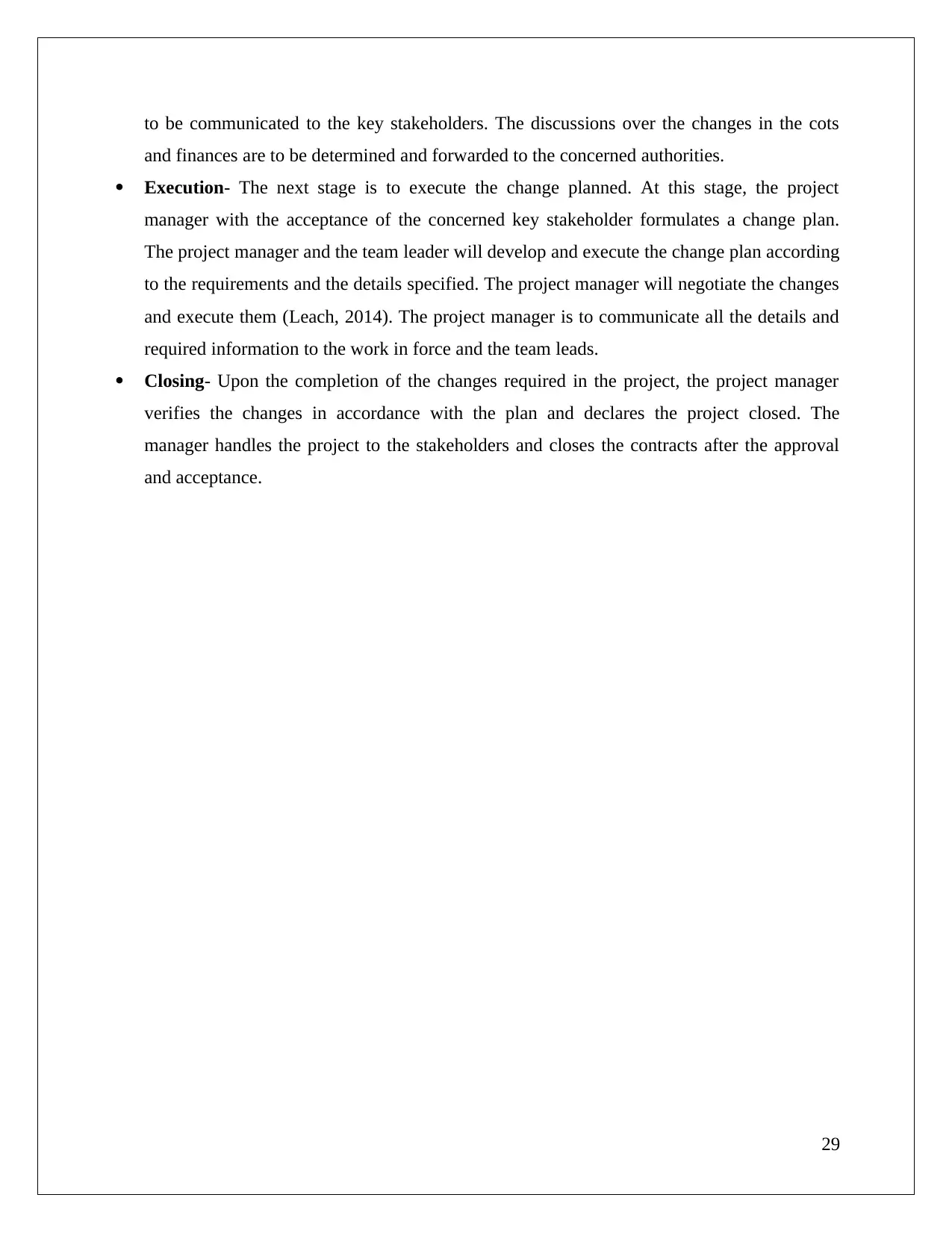
to be communicated to the key stakeholders. The discussions over the changes in the cots
and finances are to be determined and forwarded to the concerned authorities.
Execution- The next stage is to execute the change planned. At this stage, the project
manager with the acceptance of the concerned key stakeholder formulates a change plan.
The project manager and the team leader will develop and execute the change plan according
to the requirements and the details specified. The project manager will negotiate the changes
and execute them (Leach, 2014). The project manager is to communicate all the details and
required information to the work in force and the team leads.
Closing- Upon the completion of the changes required in the project, the project manager
verifies the changes in accordance with the plan and declares the project closed. The
manager handles the project to the stakeholders and closes the contracts after the approval
and acceptance.
29
and finances are to be determined and forwarded to the concerned authorities.
Execution- The next stage is to execute the change planned. At this stage, the project
manager with the acceptance of the concerned key stakeholder formulates a change plan.
The project manager and the team leader will develop and execute the change plan according
to the requirements and the details specified. The project manager will negotiate the changes
and execute them (Leach, 2014). The project manager is to communicate all the details and
required information to the work in force and the team leads.
Closing- Upon the completion of the changes required in the project, the project manager
verifies the changes in accordance with the plan and declares the project closed. The
manager handles the project to the stakeholders and closes the contracts after the approval
and acceptance.
29
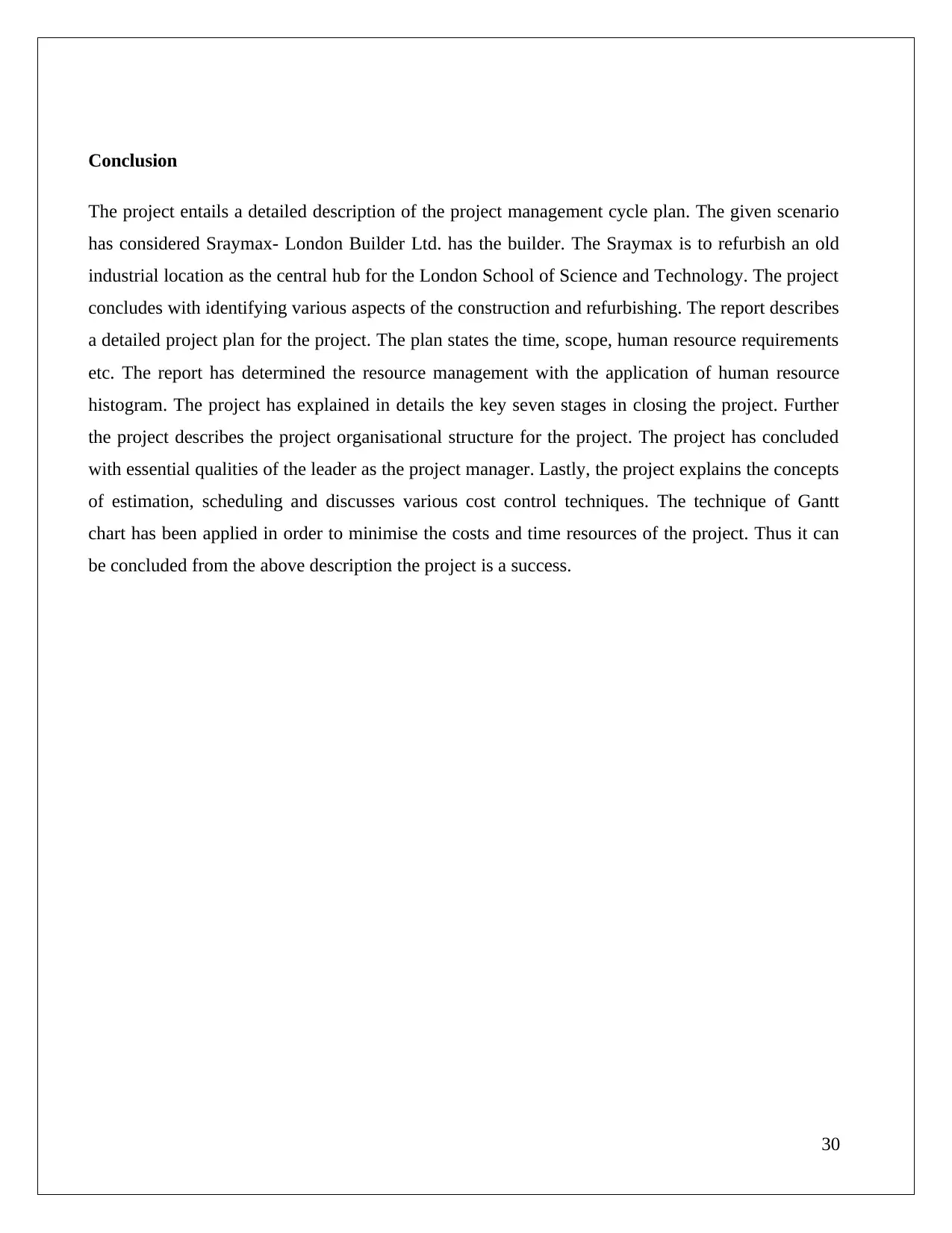
Conclusion
The project entails a detailed description of the project management cycle plan. The given scenario
has considered Sraymax- London Builder Ltd. has the builder. The Sraymax is to refurbish an old
industrial location as the central hub for the London School of Science and Technology. The project
concludes with identifying various aspects of the construction and refurbishing. The report describes
a detailed project plan for the project. The plan states the time, scope, human resource requirements
etc. The report has determined the resource management with the application of human resource
histogram. The project has explained in details the key seven stages in closing the project. Further
the project describes the project organisational structure for the project. The project has concluded
with essential qualities of the leader as the project manager. Lastly, the project explains the concepts
of estimation, scheduling and discusses various cost control techniques. The technique of Gantt
chart has been applied in order to minimise the costs and time resources of the project. Thus it can
be concluded from the above description the project is a success.
30
The project entails a detailed description of the project management cycle plan. The given scenario
has considered Sraymax- London Builder Ltd. has the builder. The Sraymax is to refurbish an old
industrial location as the central hub for the London School of Science and Technology. The project
concludes with identifying various aspects of the construction and refurbishing. The report describes
a detailed project plan for the project. The plan states the time, scope, human resource requirements
etc. The report has determined the resource management with the application of human resource
histogram. The project has explained in details the key seven stages in closing the project. Further
the project describes the project organisational structure for the project. The project has concluded
with essential qualities of the leader as the project manager. Lastly, the project explains the concepts
of estimation, scheduling and discusses various cost control techniques. The technique of Gantt
chart has been applied in order to minimise the costs and time resources of the project. Thus it can
be concluded from the above description the project is a success.
30
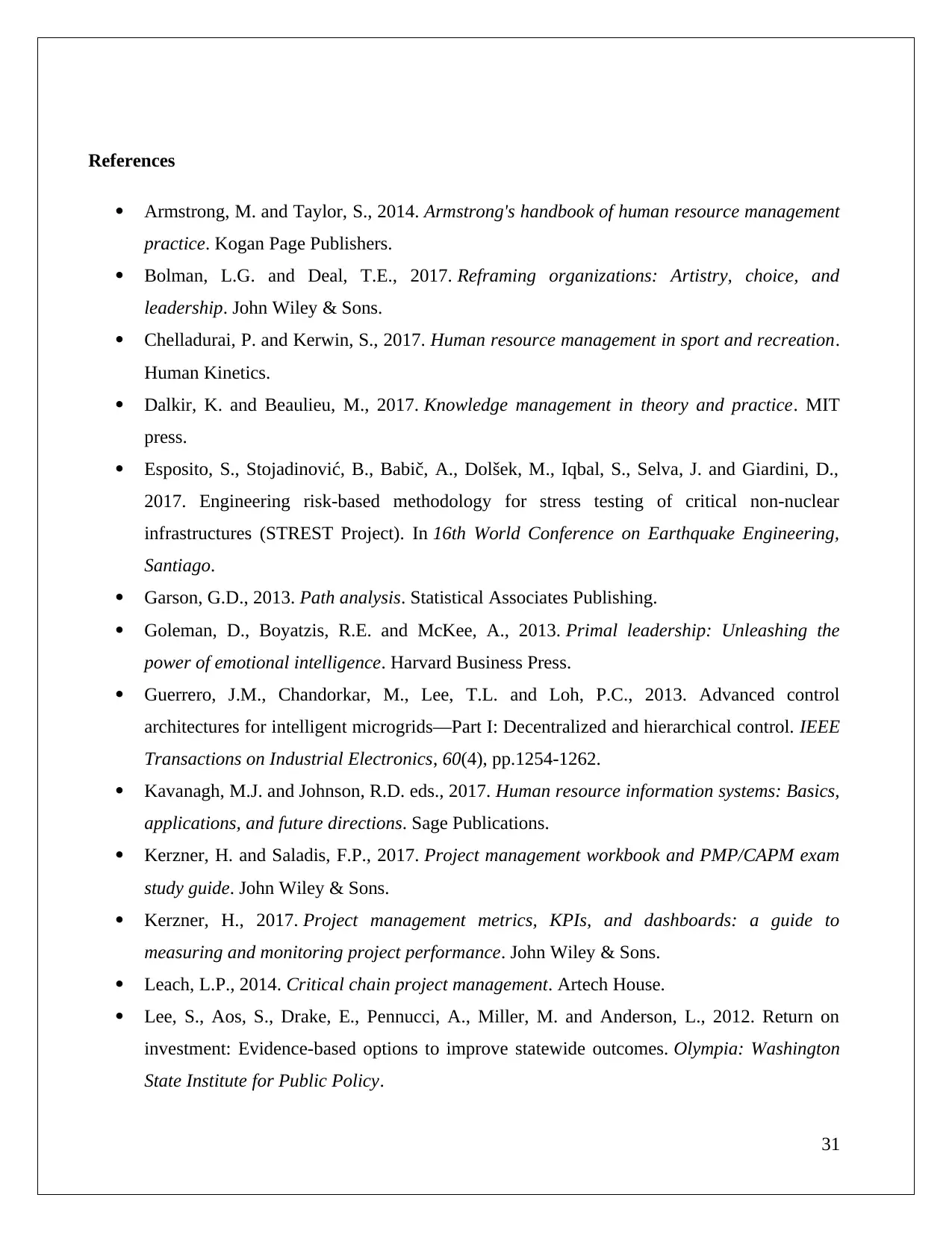
References
Armstrong, M. and Taylor, S., 2014. Armstrong's handbook of human resource management
practice. Kogan Page Publishers.
Bolman, L.G. and Deal, T.E., 2017. Reframing organizations: Artistry, choice, and
leadership. John Wiley & Sons.
Chelladurai, P. and Kerwin, S., 2017. Human resource management in sport and recreation.
Human Kinetics.
Dalkir, K. and Beaulieu, M., 2017. Knowledge management in theory and practice. MIT
press.
Esposito, S., Stojadinović, B., Babič, A., Dolšek, M., Iqbal, S., Selva, J. and Giardini, D.,
2017. Engineering risk-based methodology for stress testing of critical non-nuclear
infrastructures (STREST Project). In 16th World Conference on Earthquake Engineering,
Santiago.
Garson, G.D., 2013. Path analysis. Statistical Associates Publishing.
Goleman, D., Boyatzis, R.E. and McKee, A., 2013. Primal leadership: Unleashing the
power of emotional intelligence. Harvard Business Press.
Guerrero, J.M., Chandorkar, M., Lee, T.L. and Loh, P.C., 2013. Advanced control
architectures for intelligent microgrids—Part I: Decentralized and hierarchical control. IEEE
Transactions on Industrial Electronics, 60(4), pp.1254-1262.
Kavanagh, M.J. and Johnson, R.D. eds., 2017. Human resource information systems: Basics,
applications, and future directions. Sage Publications.
Kerzner, H. and Saladis, F.P., 2017. Project management workbook and PMP/CAPM exam
study guide. John Wiley & Sons.
Kerzner, H., 2017. Project management metrics, KPIs, and dashboards: a guide to
measuring and monitoring project performance. John Wiley & Sons.
Leach, L.P., 2014. Critical chain project management. Artech House.
Lee, S., Aos, S., Drake, E., Pennucci, A., Miller, M. and Anderson, L., 2012. Return on
investment: Evidence-based options to improve statewide outcomes. Olympia: Washington
State Institute for Public Policy.
31
Armstrong, M. and Taylor, S., 2014. Armstrong's handbook of human resource management
practice. Kogan Page Publishers.
Bolman, L.G. and Deal, T.E., 2017. Reframing organizations: Artistry, choice, and
leadership. John Wiley & Sons.
Chelladurai, P. and Kerwin, S., 2017. Human resource management in sport and recreation.
Human Kinetics.
Dalkir, K. and Beaulieu, M., 2017. Knowledge management in theory and practice. MIT
press.
Esposito, S., Stojadinović, B., Babič, A., Dolšek, M., Iqbal, S., Selva, J. and Giardini, D.,
2017. Engineering risk-based methodology for stress testing of critical non-nuclear
infrastructures (STREST Project). In 16th World Conference on Earthquake Engineering,
Santiago.
Garson, G.D., 2013. Path analysis. Statistical Associates Publishing.
Goleman, D., Boyatzis, R.E. and McKee, A., 2013. Primal leadership: Unleashing the
power of emotional intelligence. Harvard Business Press.
Guerrero, J.M., Chandorkar, M., Lee, T.L. and Loh, P.C., 2013. Advanced control
architectures for intelligent microgrids—Part I: Decentralized and hierarchical control. IEEE
Transactions on Industrial Electronics, 60(4), pp.1254-1262.
Kavanagh, M.J. and Johnson, R.D. eds., 2017. Human resource information systems: Basics,
applications, and future directions. Sage Publications.
Kerzner, H. and Saladis, F.P., 2017. Project management workbook and PMP/CAPM exam
study guide. John Wiley & Sons.
Kerzner, H., 2017. Project management metrics, KPIs, and dashboards: a guide to
measuring and monitoring project performance. John Wiley & Sons.
Leach, L.P., 2014. Critical chain project management. Artech House.
Lee, S., Aos, S., Drake, E., Pennucci, A., Miller, M. and Anderson, L., 2012. Return on
investment: Evidence-based options to improve statewide outcomes. Olympia: Washington
State Institute for Public Policy.
31
Secure Best Marks with AI Grader
Need help grading? Try our AI Grader for instant feedback on your assignments.
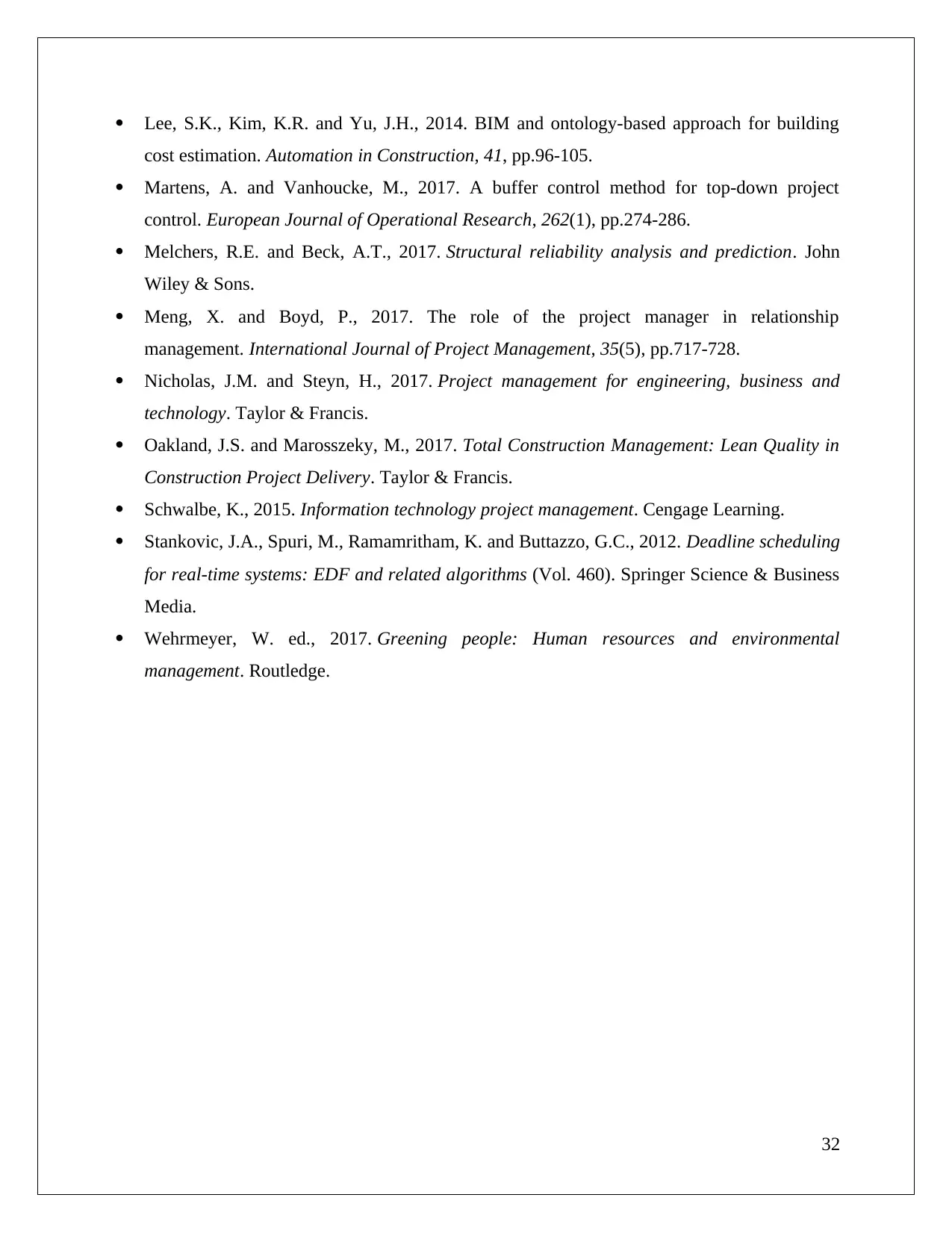
Lee, S.K., Kim, K.R. and Yu, J.H., 2014. BIM and ontology-based approach for building
cost estimation. Automation in Construction, 41, pp.96-105.
Martens, A. and Vanhoucke, M., 2017. A buffer control method for top-down project
control. European Journal of Operational Research, 262(1), pp.274-286.
Melchers, R.E. and Beck, A.T., 2017. Structural reliability analysis and prediction. John
Wiley & Sons.
Meng, X. and Boyd, P., 2017. The role of the project manager in relationship
management. International Journal of Project Management, 35(5), pp.717-728.
Nicholas, J.M. and Steyn, H., 2017. Project management for engineering, business and
technology. Taylor & Francis.
Oakland, J.S. and Marosszeky, M., 2017. Total Construction Management: Lean Quality in
Construction Project Delivery. Taylor & Francis.
Schwalbe, K., 2015. Information technology project management. Cengage Learning.
Stankovic, J.A., Spuri, M., Ramamritham, K. and Buttazzo, G.C., 2012. Deadline scheduling
for real-time systems: EDF and related algorithms (Vol. 460). Springer Science & Business
Media.
Wehrmeyer, W. ed., 2017. Greening people: Human resources and environmental
management. Routledge.
32
cost estimation. Automation in Construction, 41, pp.96-105.
Martens, A. and Vanhoucke, M., 2017. A buffer control method for top-down project
control. European Journal of Operational Research, 262(1), pp.274-286.
Melchers, R.E. and Beck, A.T., 2017. Structural reliability analysis and prediction. John
Wiley & Sons.
Meng, X. and Boyd, P., 2017. The role of the project manager in relationship
management. International Journal of Project Management, 35(5), pp.717-728.
Nicholas, J.M. and Steyn, H., 2017. Project management for engineering, business and
technology. Taylor & Francis.
Oakland, J.S. and Marosszeky, M., 2017. Total Construction Management: Lean Quality in
Construction Project Delivery. Taylor & Francis.
Schwalbe, K., 2015. Information technology project management. Cengage Learning.
Stankovic, J.A., Spuri, M., Ramamritham, K. and Buttazzo, G.C., 2012. Deadline scheduling
for real-time systems: EDF and related algorithms (Vol. 460). Springer Science & Business
Media.
Wehrmeyer, W. ed., 2017. Greening people: Human resources and environmental
management. Routledge.
32
1 out of 32
![[object Object]](/_next/static/media/star-bottom.7253800d.svg)





